Toyota Motor Corporation Analysis
VerifiedAdded on 2020/04/13
|22
|5047
|1800
AI Summary
This assignment requires an in-depth analysis of the global automotive industry with a specific focus on Toyota Motor Corporation. Students must examine Toyota's market position, competitive advantages, strategies for dealing with challenges like sustainability and technological advancements, as well as its financial performance and future prospects.
Contribute Materials
Your contribution can guide someone’s learning journey. Share your
documents today.
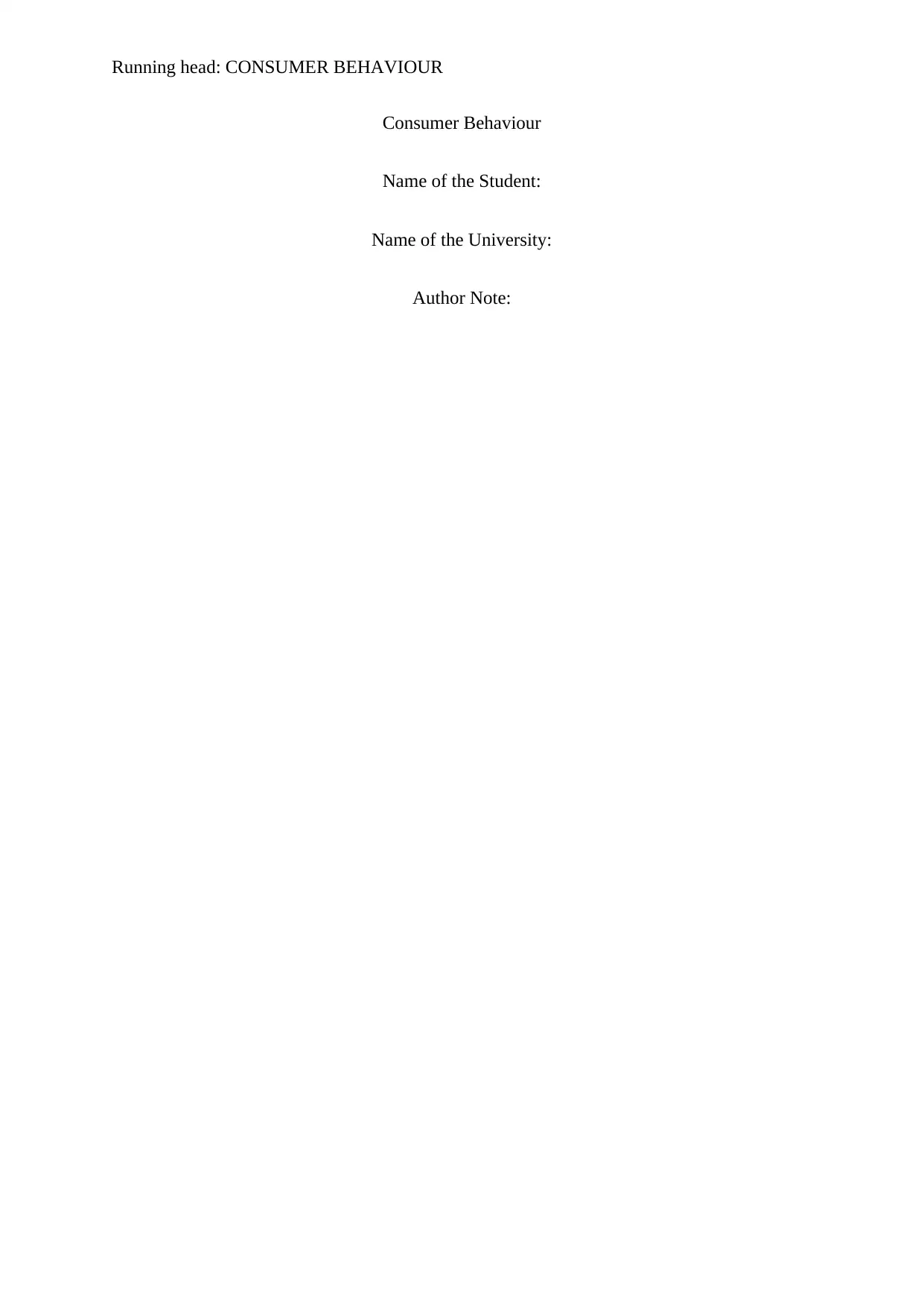
Running head: CONSUMER BEHAVIOUR
Consumer Behaviour
Name of the Student:
Name of the University:
Author Note:
Consumer Behaviour
Name of the Student:
Name of the University:
Author Note:
Secure Best Marks with AI Grader
Need help grading? Try our AI Grader for instant feedback on your assignments.
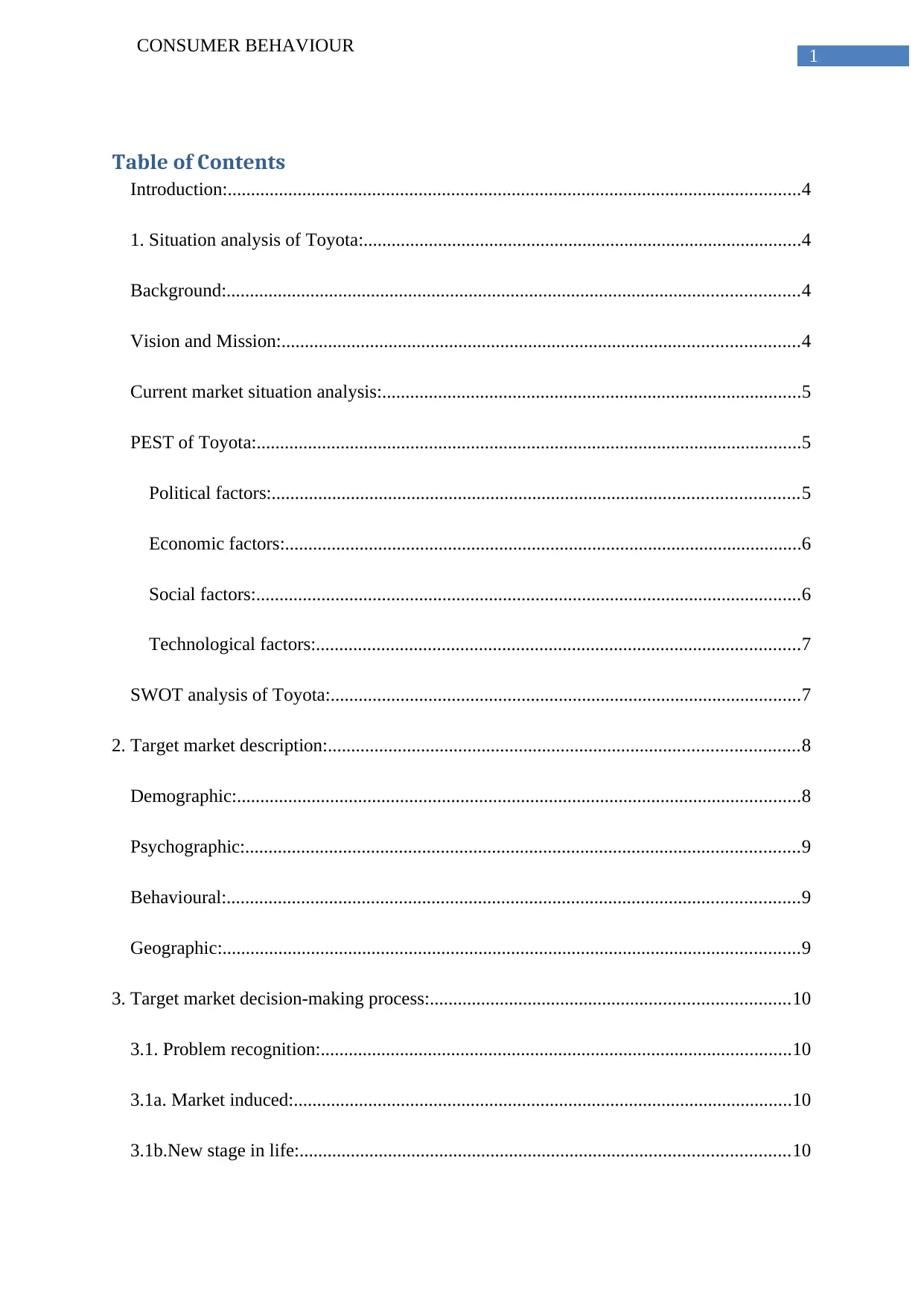
1
CONSUMER BEHAVIOUR
Table of Contents
Introduction:...........................................................................................................................4
1. Situation analysis of Toyota:..............................................................................................4
Background:...........................................................................................................................4
Vision and Mission:...............................................................................................................4
Current market situation analysis:..........................................................................................5
PEST of Toyota:.....................................................................................................................5
Political factors:.................................................................................................................5
Economic factors:...............................................................................................................6
Social factors:.....................................................................................................................6
Technological factors:........................................................................................................7
SWOT analysis of Toyota:.....................................................................................................7
2. Target market description:.....................................................................................................8
Demographic:.........................................................................................................................8
Psychographic:.......................................................................................................................9
Behavioural:...........................................................................................................................9
Geographic:............................................................................................................................9
3. Target market decision-making process:.............................................................................10
3.1. Problem recognition:.....................................................................................................10
3.1a. Market induced:...........................................................................................................10
3.1b.New stage in life:.........................................................................................................10
CONSUMER BEHAVIOUR
Table of Contents
Introduction:...........................................................................................................................4
1. Situation analysis of Toyota:..............................................................................................4
Background:...........................................................................................................................4
Vision and Mission:...............................................................................................................4
Current market situation analysis:..........................................................................................5
PEST of Toyota:.....................................................................................................................5
Political factors:.................................................................................................................5
Economic factors:...............................................................................................................6
Social factors:.....................................................................................................................6
Technological factors:........................................................................................................7
SWOT analysis of Toyota:.....................................................................................................7
2. Target market description:.....................................................................................................8
Demographic:.........................................................................................................................8
Psychographic:.......................................................................................................................9
Behavioural:...........................................................................................................................9
Geographic:............................................................................................................................9
3. Target market decision-making process:.............................................................................10
3.1. Problem recognition:.....................................................................................................10
3.1a. Market induced:...........................................................................................................10
3.1b.New stage in life:.........................................................................................................10
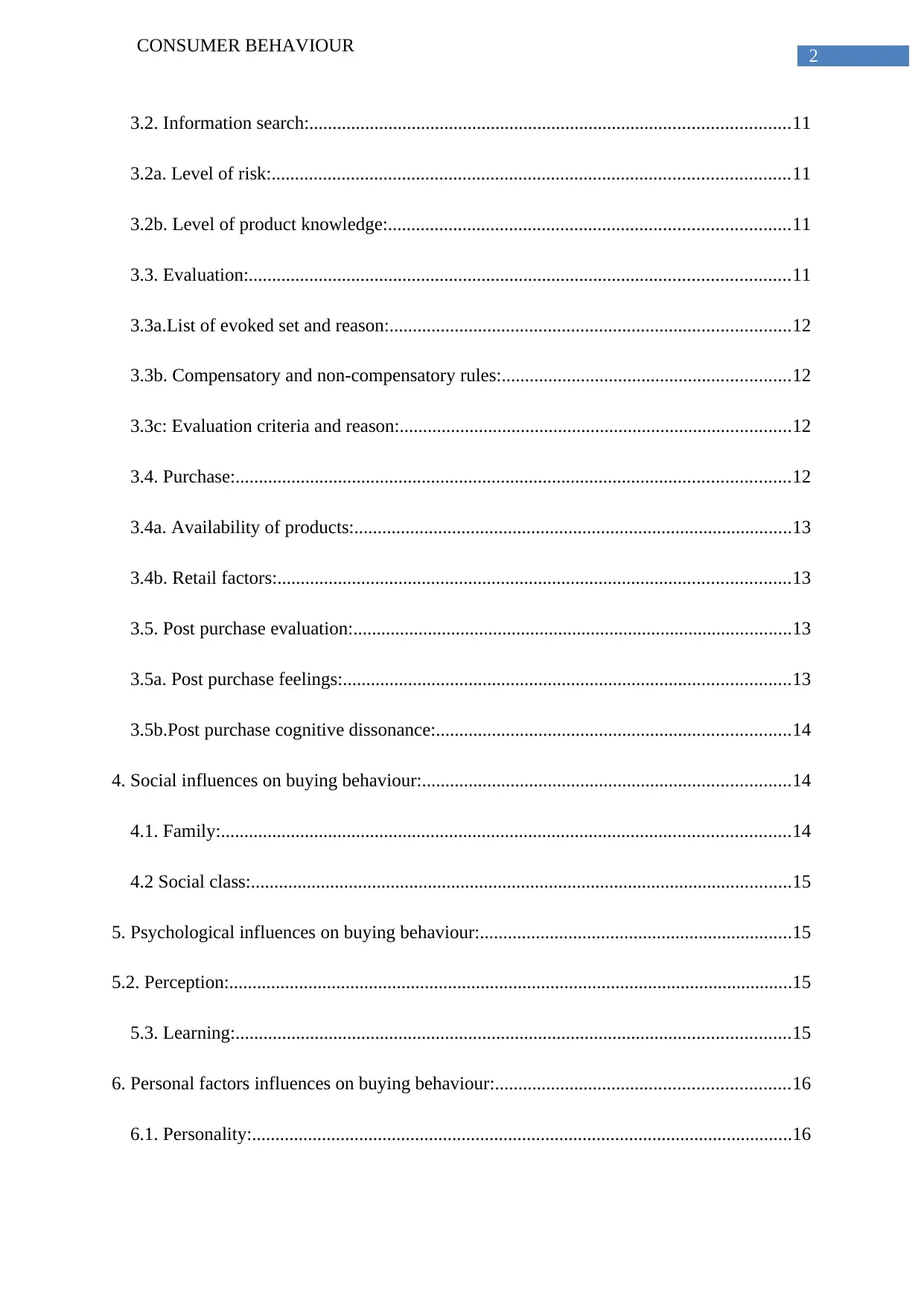
2
CONSUMER BEHAVIOUR
3.2. Information search:.......................................................................................................11
3.2a. Level of risk:...............................................................................................................11
3.2b. Level of product knowledge:......................................................................................11
3.3. Evaluation:....................................................................................................................11
3.3a.List of evoked set and reason:......................................................................................12
3.3b. Compensatory and non-compensatory rules:..............................................................12
3.3c: Evaluation criteria and reason:....................................................................................12
3.4. Purchase:.......................................................................................................................12
3.4a. Availability of products:..............................................................................................13
3.4b. Retail factors:..............................................................................................................13
3.5. Post purchase evaluation:..............................................................................................13
3.5a. Post purchase feelings:................................................................................................13
3.5b.Post purchase cognitive dissonance:............................................................................14
4. Social influences on buying behaviour:...............................................................................14
4.1. Family:..........................................................................................................................14
4.2 Social class:....................................................................................................................15
5. Psychological influences on buying behaviour:...................................................................15
5.2. Perception:.........................................................................................................................15
5.3. Learning:.......................................................................................................................15
6. Personal factors influences on buying behaviour:...............................................................16
6.1. Personality:....................................................................................................................16
CONSUMER BEHAVIOUR
3.2. Information search:.......................................................................................................11
3.2a. Level of risk:...............................................................................................................11
3.2b. Level of product knowledge:......................................................................................11
3.3. Evaluation:....................................................................................................................11
3.3a.List of evoked set and reason:......................................................................................12
3.3b. Compensatory and non-compensatory rules:..............................................................12
3.3c: Evaluation criteria and reason:....................................................................................12
3.4. Purchase:.......................................................................................................................12
3.4a. Availability of products:..............................................................................................13
3.4b. Retail factors:..............................................................................................................13
3.5. Post purchase evaluation:..............................................................................................13
3.5a. Post purchase feelings:................................................................................................13
3.5b.Post purchase cognitive dissonance:............................................................................14
4. Social influences on buying behaviour:...............................................................................14
4.1. Family:..........................................................................................................................14
4.2 Social class:....................................................................................................................15
5. Psychological influences on buying behaviour:...................................................................15
5.2. Perception:.........................................................................................................................15
5.3. Learning:.......................................................................................................................15
6. Personal factors influences on buying behaviour:...............................................................16
6.1. Personality:....................................................................................................................16
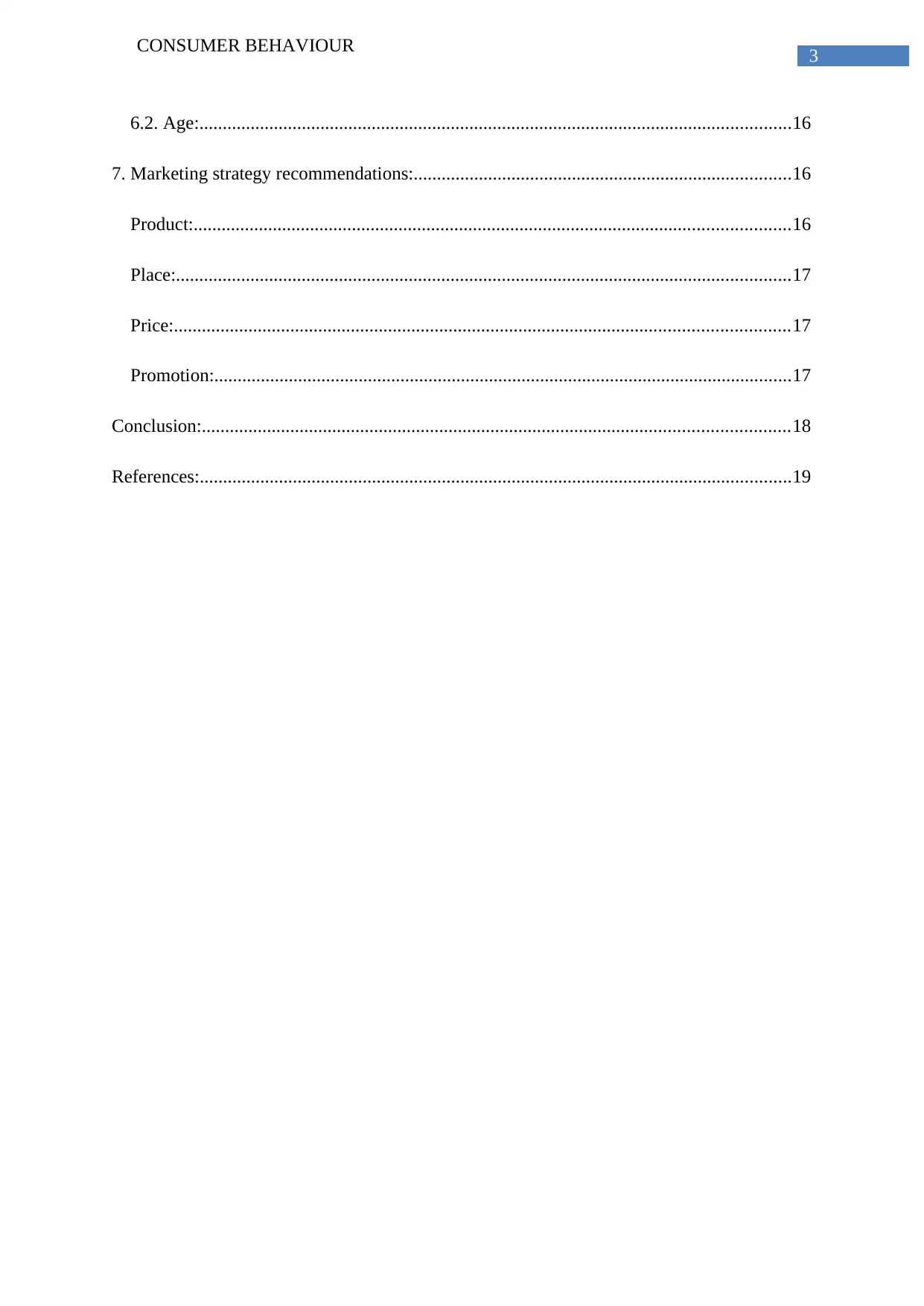
3
CONSUMER BEHAVIOUR
6.2. Age:...............................................................................................................................16
7. Marketing strategy recommendations:.................................................................................16
Product:................................................................................................................................16
Place:....................................................................................................................................17
Price:....................................................................................................................................17
Promotion:............................................................................................................................17
Conclusion:..............................................................................................................................18
References:...............................................................................................................................19
CONSUMER BEHAVIOUR
6.2. Age:...............................................................................................................................16
7. Marketing strategy recommendations:.................................................................................16
Product:................................................................................................................................16
Place:....................................................................................................................................17
Price:....................................................................................................................................17
Promotion:............................................................................................................................17
Conclusion:..............................................................................................................................18
References:...............................................................................................................................19
Secure Best Marks with AI Grader
Need help grading? Try our AI Grader for instant feedback on your assignments.
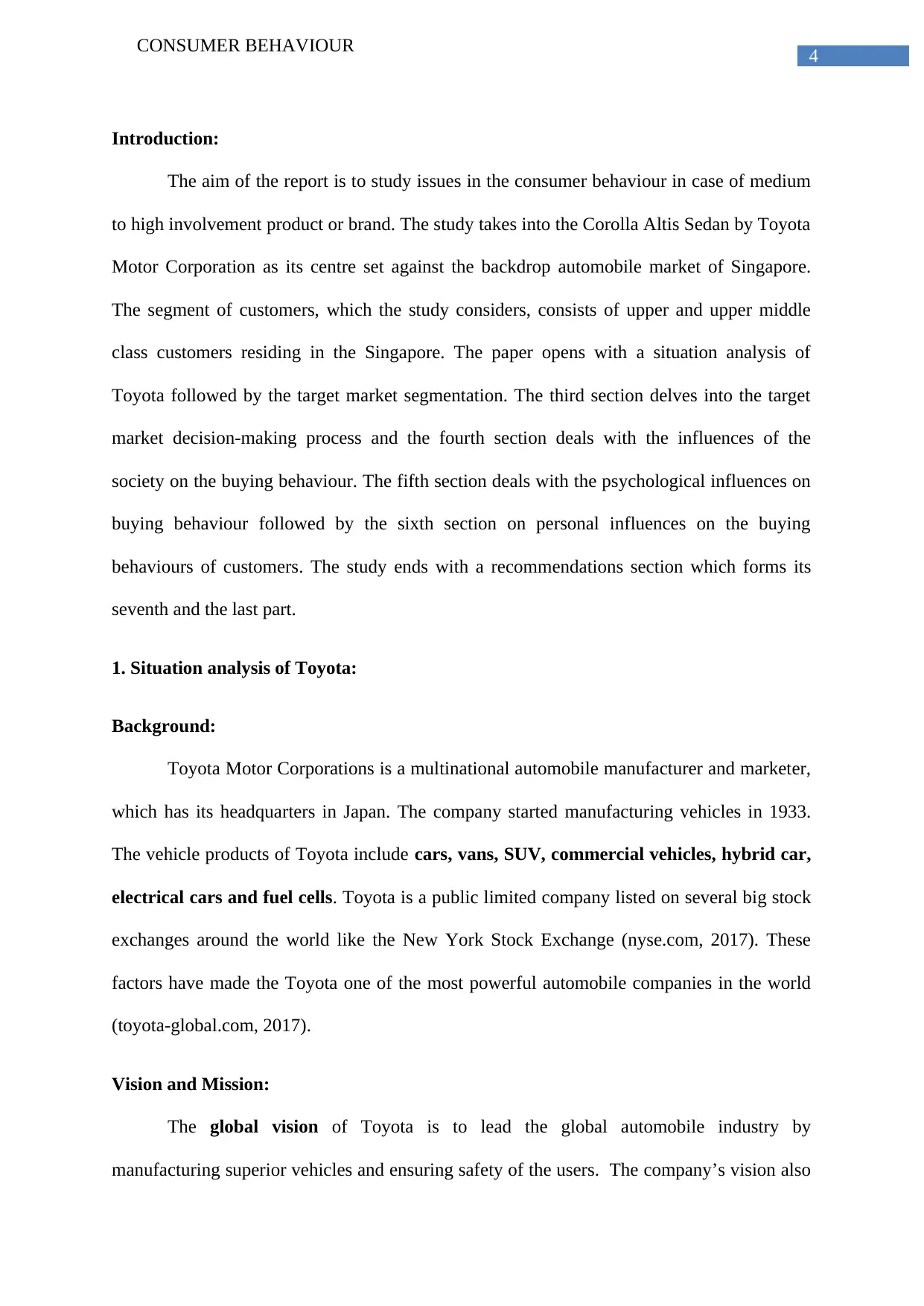
4
CONSUMER BEHAVIOUR
Introduction:
The aim of the report is to study issues in the consumer behaviour in case of medium
to high involvement product or brand. The study takes into the Corolla Altis Sedan by Toyota
Motor Corporation as its centre set against the backdrop automobile market of Singapore.
The segment of customers, which the study considers, consists of upper and upper middle
class customers residing in the Singapore. The paper opens with a situation analysis of
Toyota followed by the target market segmentation. The third section delves into the target
market decision-making process and the fourth section deals with the influences of the
society on the buying behaviour. The fifth section deals with the psychological influences on
buying behaviour followed by the sixth section on personal influences on the buying
behaviours of customers. The study ends with a recommendations section which forms its
seventh and the last part.
1. Situation analysis of Toyota:
Background:
Toyota Motor Corporations is a multinational automobile manufacturer and marketer,
which has its headquarters in Japan. The company started manufacturing vehicles in 1933.
The vehicle products of Toyota include cars, vans, SUV, commercial vehicles, hybrid car,
electrical cars and fuel cells. Toyota is a public limited company listed on several big stock
exchanges around the world like the New York Stock Exchange (nyse.com, 2017). These
factors have made the Toyota one of the most powerful automobile companies in the world
(toyota-global.com, 2017).
Vision and Mission:
The global vision of Toyota is to lead the global automobile industry by
manufacturing superior vehicles and ensuring safety of the users. The company’s vision also
CONSUMER BEHAVIOUR
Introduction:
The aim of the report is to study issues in the consumer behaviour in case of medium
to high involvement product or brand. The study takes into the Corolla Altis Sedan by Toyota
Motor Corporation as its centre set against the backdrop automobile market of Singapore.
The segment of customers, which the study considers, consists of upper and upper middle
class customers residing in the Singapore. The paper opens with a situation analysis of
Toyota followed by the target market segmentation. The third section delves into the target
market decision-making process and the fourth section deals with the influences of the
society on the buying behaviour. The fifth section deals with the psychological influences on
buying behaviour followed by the sixth section on personal influences on the buying
behaviours of customers. The study ends with a recommendations section which forms its
seventh and the last part.
1. Situation analysis of Toyota:
Background:
Toyota Motor Corporations is a multinational automobile manufacturer and marketer,
which has its headquarters in Japan. The company started manufacturing vehicles in 1933.
The vehicle products of Toyota include cars, vans, SUV, commercial vehicles, hybrid car,
electrical cars and fuel cells. Toyota is a public limited company listed on several big stock
exchanges around the world like the New York Stock Exchange (nyse.com, 2017). These
factors have made the Toyota one of the most powerful automobile companies in the world
(toyota-global.com, 2017).
Vision and Mission:
The global vision of Toyota is to lead the global automobile industry by
manufacturing superior vehicles and ensuring safety of the users. The company’s vision also
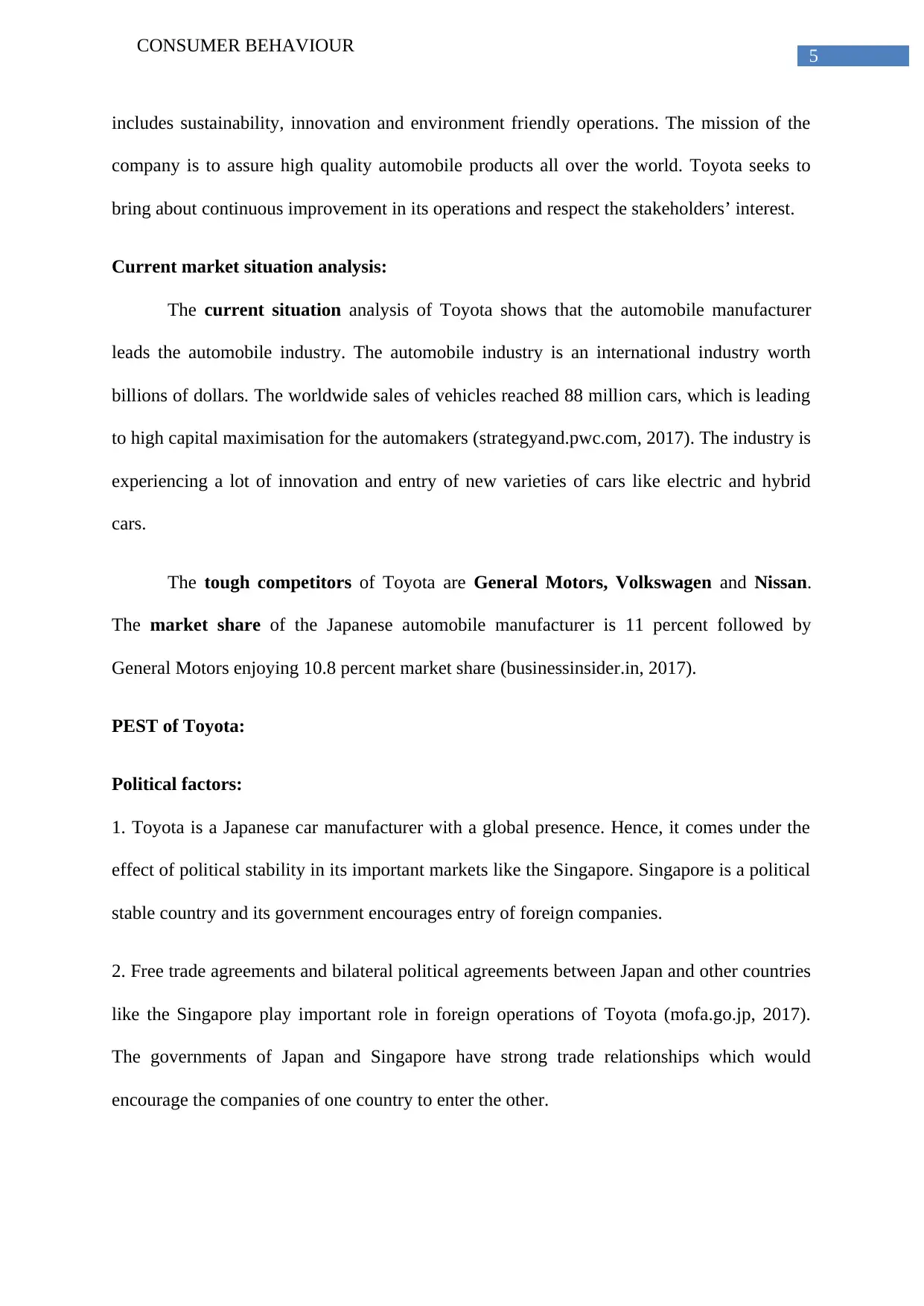
5
CONSUMER BEHAVIOUR
includes sustainability, innovation and environment friendly operations. The mission of the
company is to assure high quality automobile products all over the world. Toyota seeks to
bring about continuous improvement in its operations and respect the stakeholders’ interest.
Current market situation analysis:
The current situation analysis of Toyota shows that the automobile manufacturer
leads the automobile industry. The automobile industry is an international industry worth
billions of dollars. The worldwide sales of vehicles reached 88 million cars, which is leading
to high capital maximisation for the automakers (strategyand.pwc.com, 2017). The industry is
experiencing a lot of innovation and entry of new varieties of cars like electric and hybrid
cars.
The tough competitors of Toyota are General Motors, Volkswagen and Nissan.
The market share of the Japanese automobile manufacturer is 11 percent followed by
General Motors enjoying 10.8 percent market share (businessinsider.in, 2017).
PEST of Toyota:
Political factors:
1. Toyota is a Japanese car manufacturer with a global presence. Hence, it comes under the
effect of political stability in its important markets like the Singapore. Singapore is a political
stable country and its government encourages entry of foreign companies.
2. Free trade agreements and bilateral political agreements between Japan and other countries
like the Singapore play important role in foreign operations of Toyota (mofa.go.jp, 2017).
The governments of Japan and Singapore have strong trade relationships which would
encourage the companies of one country to enter the other.
CONSUMER BEHAVIOUR
includes sustainability, innovation and environment friendly operations. The mission of the
company is to assure high quality automobile products all over the world. Toyota seeks to
bring about continuous improvement in its operations and respect the stakeholders’ interest.
Current market situation analysis:
The current situation analysis of Toyota shows that the automobile manufacturer
leads the automobile industry. The automobile industry is an international industry worth
billions of dollars. The worldwide sales of vehicles reached 88 million cars, which is leading
to high capital maximisation for the automakers (strategyand.pwc.com, 2017). The industry is
experiencing a lot of innovation and entry of new varieties of cars like electric and hybrid
cars.
The tough competitors of Toyota are General Motors, Volkswagen and Nissan.
The market share of the Japanese automobile manufacturer is 11 percent followed by
General Motors enjoying 10.8 percent market share (businessinsider.in, 2017).
PEST of Toyota:
Political factors:
1. Toyota is a Japanese car manufacturer with a global presence. Hence, it comes under the
effect of political stability in its important markets like the Singapore. Singapore is a political
stable country and its government encourages entry of foreign companies.
2. Free trade agreements and bilateral political agreements between Japan and other countries
like the Singapore play important role in foreign operations of Toyota (mofa.go.jp, 2017).
The governments of Japan and Singapore have strong trade relationships which would
encourage the companies of one country to enter the other.
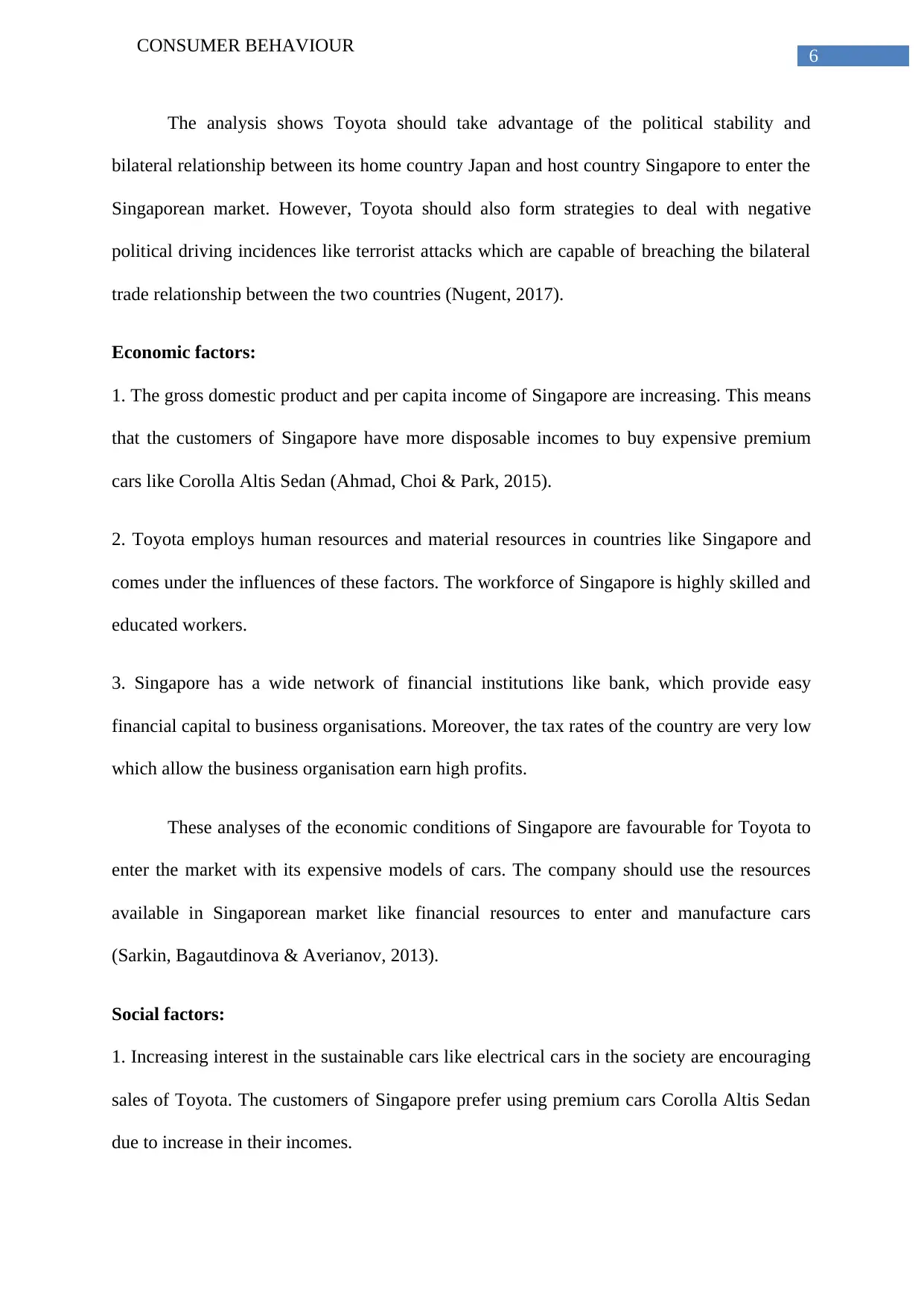
6
CONSUMER BEHAVIOUR
The analysis shows Toyota should take advantage of the political stability and
bilateral relationship between its home country Japan and host country Singapore to enter the
Singaporean market. However, Toyota should also form strategies to deal with negative
political driving incidences like terrorist attacks which are capable of breaching the bilateral
trade relationship between the two countries (Nugent, 2017).
Economic factors:
1. The gross domestic product and per capita income of Singapore are increasing. This means
that the customers of Singapore have more disposable incomes to buy expensive premium
cars like Corolla Altis Sedan (Ahmad, Choi & Park, 2015).
2. Toyota employs human resources and material resources in countries like Singapore and
comes under the influences of these factors. The workforce of Singapore is highly skilled and
educated workers.
3. Singapore has a wide network of financial institutions like bank, which provide easy
financial capital to business organisations. Moreover, the tax rates of the country are very low
which allow the business organisation earn high profits.
These analyses of the economic conditions of Singapore are favourable for Toyota to
enter the market with its expensive models of cars. The company should use the resources
available in Singaporean market like financial resources to enter and manufacture cars
(Sarkin, Bagautdinova & Averianov, 2013).
Social factors:
1. Increasing interest in the sustainable cars like electrical cars in the society are encouraging
sales of Toyota. The customers of Singapore prefer using premium cars Corolla Altis Sedan
due to increase in their incomes.
CONSUMER BEHAVIOUR
The analysis shows Toyota should take advantage of the political stability and
bilateral relationship between its home country Japan and host country Singapore to enter the
Singaporean market. However, Toyota should also form strategies to deal with negative
political driving incidences like terrorist attacks which are capable of breaching the bilateral
trade relationship between the two countries (Nugent, 2017).
Economic factors:
1. The gross domestic product and per capita income of Singapore are increasing. This means
that the customers of Singapore have more disposable incomes to buy expensive premium
cars like Corolla Altis Sedan (Ahmad, Choi & Park, 2015).
2. Toyota employs human resources and material resources in countries like Singapore and
comes under the influences of these factors. The workforce of Singapore is highly skilled and
educated workers.
3. Singapore has a wide network of financial institutions like bank, which provide easy
financial capital to business organisations. Moreover, the tax rates of the country are very low
which allow the business organisation earn high profits.
These analyses of the economic conditions of Singapore are favourable for Toyota to
enter the market with its expensive models of cars. The company should use the resources
available in Singaporean market like financial resources to enter and manufacture cars
(Sarkin, Bagautdinova & Averianov, 2013).
Social factors:
1. Increasing interest in the sustainable cars like electrical cars in the society are encouraging
sales of Toyota. The customers of Singapore prefer using premium cars Corolla Altis Sedan
due to increase in their incomes.
Paraphrase This Document
Need a fresh take? Get an instant paraphrase of this document with our AI Paraphraser

7
CONSUMER BEHAVIOUR
2. Dynamic changes of preferences among customers in Singapore about cars require the
companies like Toyota to carry out continuous innovation in their automobile manufacturing
method.
This analysis shows that the social conditions of Singapore favours Toyota to expand
its business in Singapore by selling premium cars like Corolla Altis Sedan. As discussed, the
people of Singapore prefer expensive cars, which would allow Toyota to sell its expensive
models among the people to earn huge revenue.
Technological factors:
1.The market of Singapore is technologically advanced and encourages high level of
automation in factories. This availability of advanced technology encourages innovation
among the companies.
2. Technological advancements have allowed Toyota to manufacture more sustainable and
eco-friendly cars like the electric car. This is proving to be opportunity for Toyota and
boosting its sales (Anderson et al., 2014).
3. Cyber crime and data threat are the major technological threats facing the automobile
companies like Toyota (Feher, 2015).
This analysis shows that Singapore is technologically advanced and encourages
innovations. Toyota should make use of this technological advancement to manufacture and
sell premium models like Corolla Altis Sedan. However, the company should be aware of
cyber crime, which can cause potential harm its business.
SWOT analysis of Toyota:
An analysis of the macro-environment of Toyota reveal the following strengths,
weaknesses, opportunities and threats the company encounters:
CONSUMER BEHAVIOUR
2. Dynamic changes of preferences among customers in Singapore about cars require the
companies like Toyota to carry out continuous innovation in their automobile manufacturing
method.
This analysis shows that the social conditions of Singapore favours Toyota to expand
its business in Singapore by selling premium cars like Corolla Altis Sedan. As discussed, the
people of Singapore prefer expensive cars, which would allow Toyota to sell its expensive
models among the people to earn huge revenue.
Technological factors:
1.The market of Singapore is technologically advanced and encourages high level of
automation in factories. This availability of advanced technology encourages innovation
among the companies.
2. Technological advancements have allowed Toyota to manufacture more sustainable and
eco-friendly cars like the electric car. This is proving to be opportunity for Toyota and
boosting its sales (Anderson et al., 2014).
3. Cyber crime and data threat are the major technological threats facing the automobile
companies like Toyota (Feher, 2015).
This analysis shows that Singapore is technologically advanced and encourages
innovations. Toyota should make use of this technological advancement to manufacture and
sell premium models like Corolla Altis Sedan. However, the company should be aware of
cyber crime, which can cause potential harm its business.
SWOT analysis of Toyota:
An analysis of the macro-environment of Toyota reveal the following strengths,
weaknesses, opportunities and threats the company encounters:
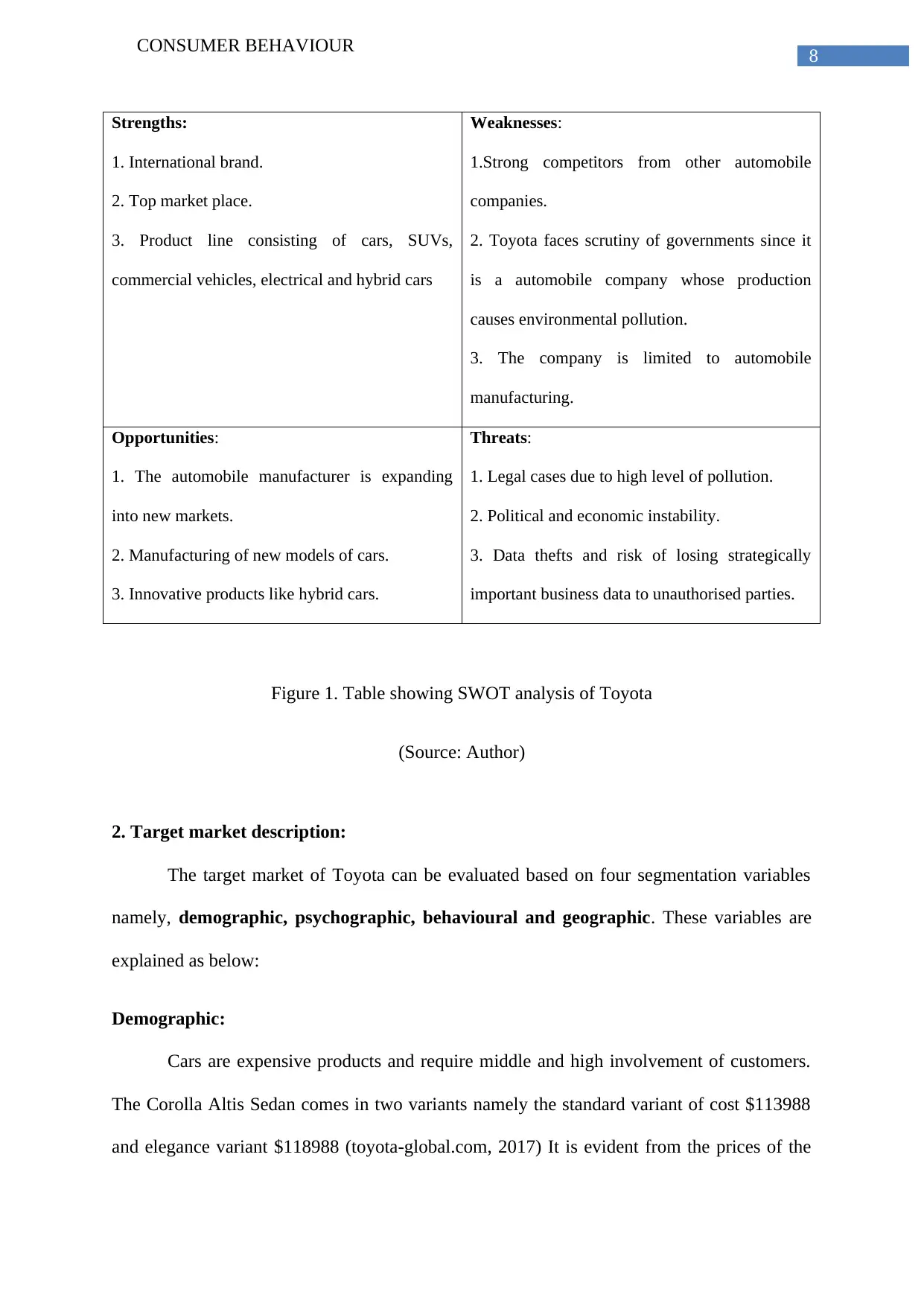
8
CONSUMER BEHAVIOUR
Strengths:
1. International brand.
2. Top market place.
3. Product line consisting of cars, SUVs,
commercial vehicles, electrical and hybrid cars
Weaknesses:
1.Strong competitors from other automobile
companies.
2. Toyota faces scrutiny of governments since it
is a automobile company whose production
causes environmental pollution.
3. The company is limited to automobile
manufacturing.
Opportunities:
1. The automobile manufacturer is expanding
into new markets.
2. Manufacturing of new models of cars.
3. Innovative products like hybrid cars.
Threats:
1. Legal cases due to high level of pollution.
2. Political and economic instability.
3. Data thefts and risk of losing strategically
important business data to unauthorised parties.
Figure 1. Table showing SWOT analysis of Toyota
(Source: Author)
2. Target market description:
The target market of Toyota can be evaluated based on four segmentation variables
namely, demographic, psychographic, behavioural and geographic. These variables are
explained as below:
Demographic:
Cars are expensive products and require middle and high involvement of customers.
The Corolla Altis Sedan comes in two variants namely the standard variant of cost $113988
and elegance variant $118988 (toyota-global.com, 2017) It is evident from the prices of the
CONSUMER BEHAVIOUR
Strengths:
1. International brand.
2. Top market place.
3. Product line consisting of cars, SUVs,
commercial vehicles, electrical and hybrid cars
Weaknesses:
1.Strong competitors from other automobile
companies.
2. Toyota faces scrutiny of governments since it
is a automobile company whose production
causes environmental pollution.
3. The company is limited to automobile
manufacturing.
Opportunities:
1. The automobile manufacturer is expanding
into new markets.
2. Manufacturing of new models of cars.
3. Innovative products like hybrid cars.
Threats:
1. Legal cases due to high level of pollution.
2. Political and economic instability.
3. Data thefts and risk of losing strategically
important business data to unauthorised parties.
Figure 1. Table showing SWOT analysis of Toyota
(Source: Author)
2. Target market description:
The target market of Toyota can be evaluated based on four segmentation variables
namely, demographic, psychographic, behavioural and geographic. These variables are
explained as below:
Demographic:
Cars are expensive products and require middle and high involvement of customers.
The Corolla Altis Sedan comes in two variants namely the standard variant of cost $113988
and elegance variant $118988 (toyota-global.com, 2017) It is evident from the prices of the

9
CONSUMER BEHAVIOUR
model that the target customer profiles are the upper middle and the upper class customers.
The company makes expensive and sophisticated models, which match up the tastes of the
upper class customers (Parise, Guinan & Kafka, 2016). The high quality original spare parts
and services available at the service outlets all over the world enhance the customer purchase
experience about Toyota products.
Psychographic:
Psychographic segmentation of the customers takes into consideration factors like
lifestyle, values, social and personality, which represent their social status. Corolla Altis
targets the upper and upper class customers who view cars as status symbol. They consider
the high price of the cars manufactured by Toyota as the sign of high quality and status
(Shende, 2014).
Behavioural:
The behavioural segmentation of the customers Toyota serves consists of middle,
upper middle and upper class people. Corolla Altis is meant particularly the upper and the
upper middle class people who have considerable knowledge about cars and use them on
daily basis. These classes of customers show great involvement while purchasing premium
cars and enjoy driving them (González, Cárcaba, & Ventura, 2015).
Geographic:
The geographic segmentation of Toyota customer profile consists of upper and upper
middle class customers all over the world. Toyota has strong presence in all the major
markets and occupies high position in them. The company owns supply chain and distribution
chains all over the world. These chains ensue that Toyota is able to sell its high priced cars to
the rich people all over the world (Athreye, Tuncay-Celikel & Ujjual, 2014). Toyota has
services centres all over the world. This geographically vast network of service centres allow
CONSUMER BEHAVIOUR
model that the target customer profiles are the upper middle and the upper class customers.
The company makes expensive and sophisticated models, which match up the tastes of the
upper class customers (Parise, Guinan & Kafka, 2016). The high quality original spare parts
and services available at the service outlets all over the world enhance the customer purchase
experience about Toyota products.
Psychographic:
Psychographic segmentation of the customers takes into consideration factors like
lifestyle, values, social and personality, which represent their social status. Corolla Altis
targets the upper and upper class customers who view cars as status symbol. They consider
the high price of the cars manufactured by Toyota as the sign of high quality and status
(Shende, 2014).
Behavioural:
The behavioural segmentation of the customers Toyota serves consists of middle,
upper middle and upper class people. Corolla Altis is meant particularly the upper and the
upper middle class people who have considerable knowledge about cars and use them on
daily basis. These classes of customers show great involvement while purchasing premium
cars and enjoy driving them (González, Cárcaba, & Ventura, 2015).
Geographic:
The geographic segmentation of Toyota customer profile consists of upper and upper
middle class customers all over the world. Toyota has strong presence in all the major
markets and occupies high position in them. The company owns supply chain and distribution
chains all over the world. These chains ensue that Toyota is able to sell its high priced cars to
the rich people all over the world (Athreye, Tuncay-Celikel & Ujjual, 2014). Toyota has
services centres all over the world. This geographically vast network of service centres allow
Secure Best Marks with AI Grader
Need help grading? Try our AI Grader for instant feedback on your assignments.

10
CONSUMER BEHAVIOUR
the company to cater to the needs of the rich people by offering them genuine parts for
expensive their Toyota cars. This availability of Toyota showrooms and services all over the
world encourages the upper class buy their cars because of after sales services (Murali,
Pugazhendhi & Muralidharan, 2016).
3. Target market decision-making process:
The target market of Toyota consists of the rich and the upper middle class customers
which make decisions regarding the purchase of expensive car models like Corolla Altis.
Corolla Altis is a premium car and hence, the customers show high involvement while
making purchase decisions consisting of the following five steps:
3.1. Problem recognition:
The target market of the customers of Toyota consisting of rich and upper middle
class customers identify the problem or the need to buy an expensive car. The need can be a
want of a luxurious premium car which modern features and sophisticated look which can
function as a status symbol (Qian, & Soopramanien, 2015).
3.1a. Market induced:
The main market of the expensive models of Toyota like Corolla Altis consists of
upper and upper-middle class customers who have high disposable incomes to buy luxurious
cars. However, with the increase in the income of the middle class in Singapore, the induced
market for the company consists of the middle class customers as well. These middle class
customers today are also preferring premium cars to exhibit their increased income and social
status (Kearney & Levine, 2014).
CONSUMER BEHAVIOUR
the company to cater to the needs of the rich people by offering them genuine parts for
expensive their Toyota cars. This availability of Toyota showrooms and services all over the
world encourages the upper class buy their cars because of after sales services (Murali,
Pugazhendhi & Muralidharan, 2016).
3. Target market decision-making process:
The target market of Toyota consists of the rich and the upper middle class customers
which make decisions regarding the purchase of expensive car models like Corolla Altis.
Corolla Altis is a premium car and hence, the customers show high involvement while
making purchase decisions consisting of the following five steps:
3.1. Problem recognition:
The target market of the customers of Toyota consisting of rich and upper middle
class customers identify the problem or the need to buy an expensive car. The need can be a
want of a luxurious premium car which modern features and sophisticated look which can
function as a status symbol (Qian, & Soopramanien, 2015).
3.1a. Market induced:
The main market of the expensive models of Toyota like Corolla Altis consists of
upper and upper-middle class customers who have high disposable incomes to buy luxurious
cars. However, with the increase in the income of the middle class in Singapore, the induced
market for the company consists of the middle class customers as well. These middle class
customers today are also preferring premium cars to exhibit their increased income and social
status (Kearney & Levine, 2014).
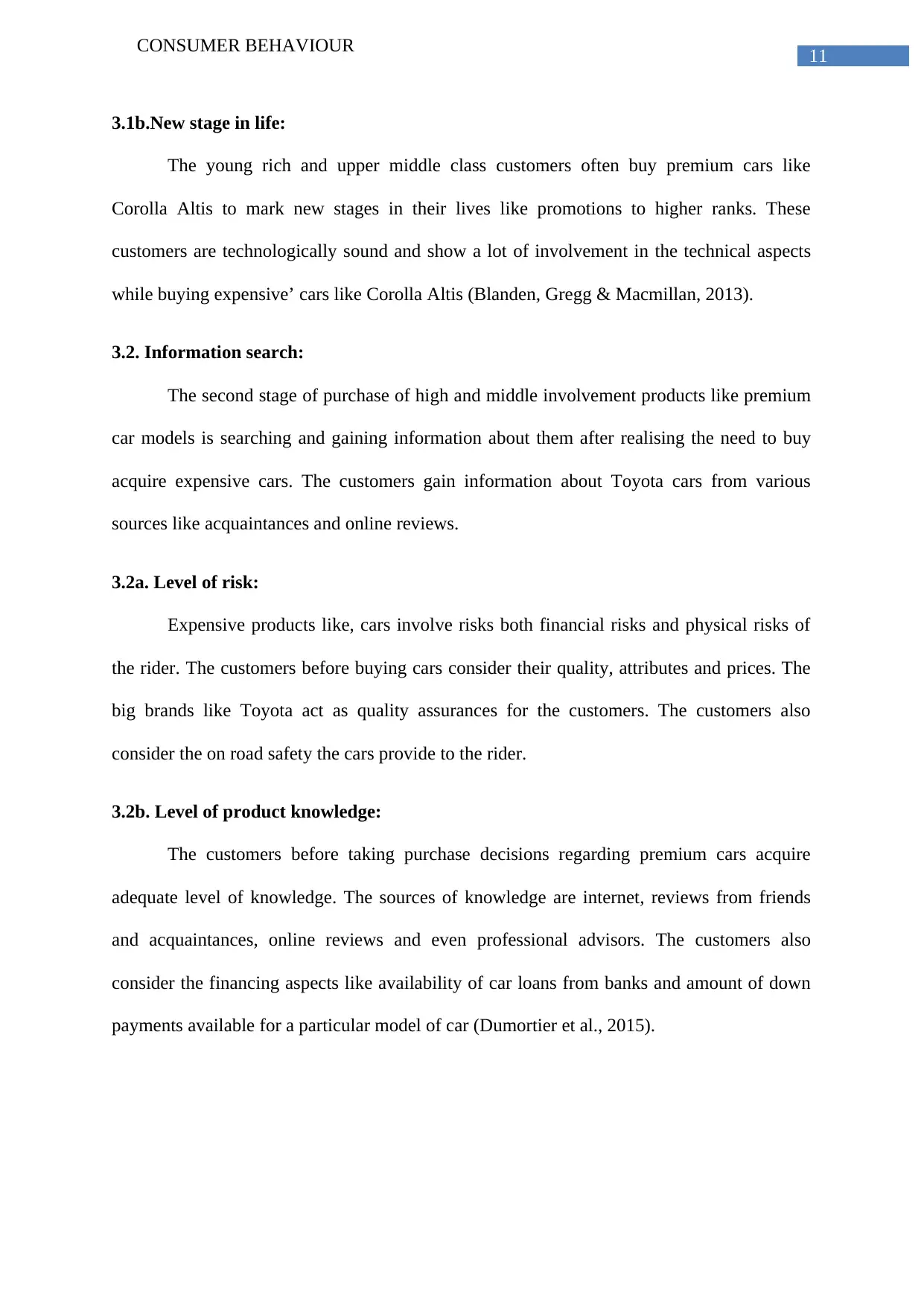
11
CONSUMER BEHAVIOUR
3.1b.New stage in life:
The young rich and upper middle class customers often buy premium cars like
Corolla Altis to mark new stages in their lives like promotions to higher ranks. These
customers are technologically sound and show a lot of involvement in the technical aspects
while buying expensive’ cars like Corolla Altis (Blanden, Gregg & Macmillan, 2013).
3.2. Information search:
The second stage of purchase of high and middle involvement products like premium
car models is searching and gaining information about them after realising the need to buy
acquire expensive cars. The customers gain information about Toyota cars from various
sources like acquaintances and online reviews.
3.2a. Level of risk:
Expensive products like, cars involve risks both financial risks and physical risks of
the rider. The customers before buying cars consider their quality, attributes and prices. The
big brands like Toyota act as quality assurances for the customers. The customers also
consider the on road safety the cars provide to the rider.
3.2b. Level of product knowledge:
The customers before taking purchase decisions regarding premium cars acquire
adequate level of knowledge. The sources of knowledge are internet, reviews from friends
and acquaintances, online reviews and even professional advisors. The customers also
consider the financing aspects like availability of car loans from banks and amount of down
payments available for a particular model of car (Dumortier et al., 2015).
CONSUMER BEHAVIOUR
3.1b.New stage in life:
The young rich and upper middle class customers often buy premium cars like
Corolla Altis to mark new stages in their lives like promotions to higher ranks. These
customers are technologically sound and show a lot of involvement in the technical aspects
while buying expensive’ cars like Corolla Altis (Blanden, Gregg & Macmillan, 2013).
3.2. Information search:
The second stage of purchase of high and middle involvement products like premium
car models is searching and gaining information about them after realising the need to buy
acquire expensive cars. The customers gain information about Toyota cars from various
sources like acquaintances and online reviews.
3.2a. Level of risk:
Expensive products like, cars involve risks both financial risks and physical risks of
the rider. The customers before buying cars consider their quality, attributes and prices. The
big brands like Toyota act as quality assurances for the customers. The customers also
consider the on road safety the cars provide to the rider.
3.2b. Level of product knowledge:
The customers before taking purchase decisions regarding premium cars acquire
adequate level of knowledge. The sources of knowledge are internet, reviews from friends
and acquaintances, online reviews and even professional advisors. The customers also
consider the financing aspects like availability of car loans from banks and amount of down
payments available for a particular model of car (Dumortier et al., 2015).

12
CONSUMER BEHAVIOUR
3.3. Evaluation:
The next step in making purchase decisions is evaluation of the knowledge gained
from various sources like online reviews. The customers compare and contrast between car
models and aspects like financing available for them at this stage.
3.3a.List of evoked set and reason:
The customers while evaluating between models of cars, create evoke sets consisting
of brands of premium cars they are familiar with. The evoked list of premium cars usually
consists brands like Toyota, which offer cars with modern features, which match with the
tastes of the upper class customer segment. Moreover, banks usually provide financing for
such luxury models at lower rates of interests. The attributes of the premium cars like Toyota
Corolla Altis and easily available financing facilities are the reasons why customers consider
them while making purchase decisions of buying cars (Zhang et al., 2014).
3.3b. Compensatory and non-compensatory rules:
The compensatory rules consist of attributes which customers are not definite about
while non-compensatory rules are compulsory attributes which customers consider while
making purchase decisions. As far as buying premium cars are concerned, the non-
compensatory rules comprise of features and safety parameters available in a model. The
non-compensatory rules consist of features like, colours which if differ will not affect the
rider safety and convenience.
3.3c: Evaluation criteria and reason:
The evaluation criteria consist of the compensatory attributes like colours and non-
compensatory attributes like features and on-road safety. The customers available the
available car models based on these attributes to make the final purchase decision.
CONSUMER BEHAVIOUR
3.3. Evaluation:
The next step in making purchase decisions is evaluation of the knowledge gained
from various sources like online reviews. The customers compare and contrast between car
models and aspects like financing available for them at this stage.
3.3a.List of evoked set and reason:
The customers while evaluating between models of cars, create evoke sets consisting
of brands of premium cars they are familiar with. The evoked list of premium cars usually
consists brands like Toyota, which offer cars with modern features, which match with the
tastes of the upper class customer segment. Moreover, banks usually provide financing for
such luxury models at lower rates of interests. The attributes of the premium cars like Toyota
Corolla Altis and easily available financing facilities are the reasons why customers consider
them while making purchase decisions of buying cars (Zhang et al., 2014).
3.3b. Compensatory and non-compensatory rules:
The compensatory rules consist of attributes which customers are not definite about
while non-compensatory rules are compulsory attributes which customers consider while
making purchase decisions. As far as buying premium cars are concerned, the non-
compensatory rules comprise of features and safety parameters available in a model. The
non-compensatory rules consist of features like, colours which if differ will not affect the
rider safety and convenience.
3.3c: Evaluation criteria and reason:
The evaluation criteria consist of the compensatory attributes like colours and non-
compensatory attributes like features and on-road safety. The customers available the
available car models based on these attributes to make the final purchase decision.
Paraphrase This Document
Need a fresh take? Get an instant paraphrase of this document with our AI Paraphraser
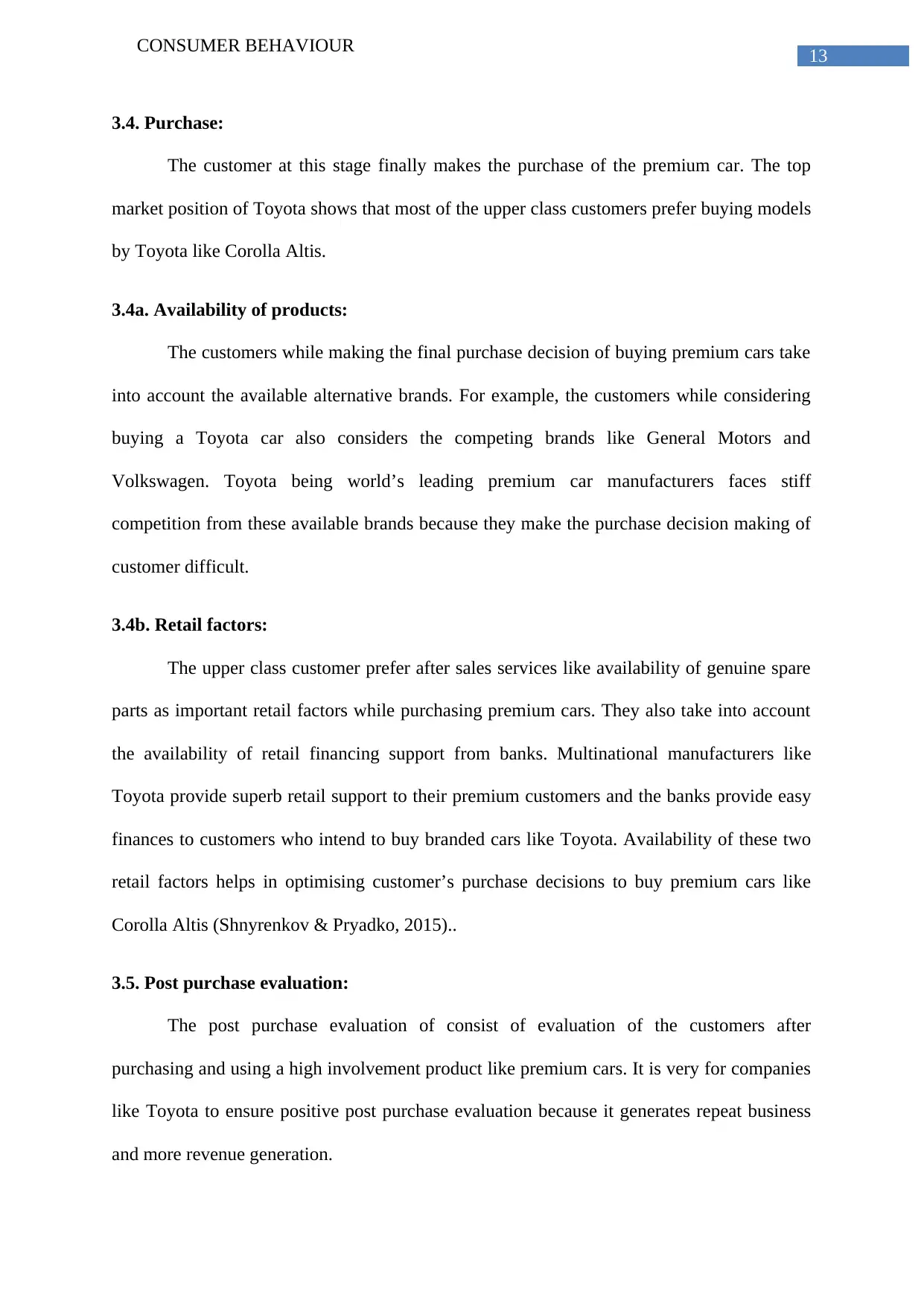
13
CONSUMER BEHAVIOUR
3.4. Purchase:
The customer at this stage finally makes the purchase of the premium car. The top
market position of Toyota shows that most of the upper class customers prefer buying models
by Toyota like Corolla Altis.
3.4a. Availability of products:
The customers while making the final purchase decision of buying premium cars take
into account the available alternative brands. For example, the customers while considering
buying a Toyota car also considers the competing brands like General Motors and
Volkswagen. Toyota being world’s leading premium car manufacturers faces stiff
competition from these available brands because they make the purchase decision making of
customer difficult.
3.4b. Retail factors:
The upper class customer prefer after sales services like availability of genuine spare
parts as important retail factors while purchasing premium cars. They also take into account
the availability of retail financing support from banks. Multinational manufacturers like
Toyota provide superb retail support to their premium customers and the banks provide easy
finances to customers who intend to buy branded cars like Toyota. Availability of these two
retail factors helps in optimising customer’s purchase decisions to buy premium cars like
Corolla Altis (Shnyrenkov & Pryadko, 2015)..
3.5. Post purchase evaluation:
The post purchase evaluation of consist of evaluation of the customers after
purchasing and using a high involvement product like premium cars. It is very for companies
like Toyota to ensure positive post purchase evaluation because it generates repeat business
and more revenue generation.
CONSUMER BEHAVIOUR
3.4. Purchase:
The customer at this stage finally makes the purchase of the premium car. The top
market position of Toyota shows that most of the upper class customers prefer buying models
by Toyota like Corolla Altis.
3.4a. Availability of products:
The customers while making the final purchase decision of buying premium cars take
into account the available alternative brands. For example, the customers while considering
buying a Toyota car also considers the competing brands like General Motors and
Volkswagen. Toyota being world’s leading premium car manufacturers faces stiff
competition from these available brands because they make the purchase decision making of
customer difficult.
3.4b. Retail factors:
The upper class customer prefer after sales services like availability of genuine spare
parts as important retail factors while purchasing premium cars. They also take into account
the availability of retail financing support from banks. Multinational manufacturers like
Toyota provide superb retail support to their premium customers and the banks provide easy
finances to customers who intend to buy branded cars like Toyota. Availability of these two
retail factors helps in optimising customer’s purchase decisions to buy premium cars like
Corolla Altis (Shnyrenkov & Pryadko, 2015)..
3.5. Post purchase evaluation:
The post purchase evaluation of consist of evaluation of the customers after
purchasing and using a high involvement product like premium cars. It is very for companies
like Toyota to ensure positive post purchase evaluation because it generates repeat business
and more revenue generation.
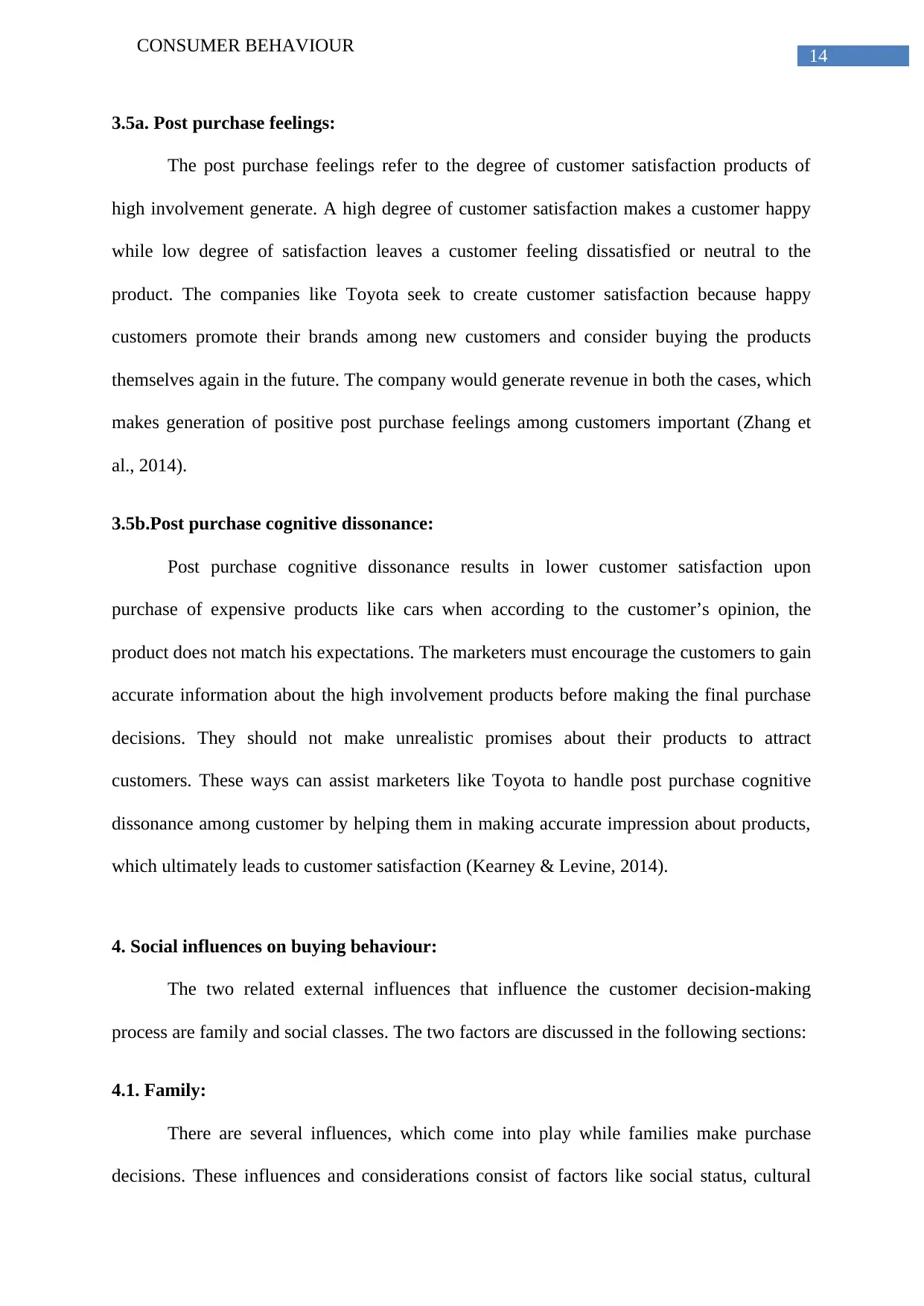
14
CONSUMER BEHAVIOUR
3.5a. Post purchase feelings:
The post purchase feelings refer to the degree of customer satisfaction products of
high involvement generate. A high degree of customer satisfaction makes a customer happy
while low degree of satisfaction leaves a customer feeling dissatisfied or neutral to the
product. The companies like Toyota seek to create customer satisfaction because happy
customers promote their brands among new customers and consider buying the products
themselves again in the future. The company would generate revenue in both the cases, which
makes generation of positive post purchase feelings among customers important (Zhang et
al., 2014).
3.5b.Post purchase cognitive dissonance:
Post purchase cognitive dissonance results in lower customer satisfaction upon
purchase of expensive products like cars when according to the customer’s opinion, the
product does not match his expectations. The marketers must encourage the customers to gain
accurate information about the high involvement products before making the final purchase
decisions. They should not make unrealistic promises about their products to attract
customers. These ways can assist marketers like Toyota to handle post purchase cognitive
dissonance among customer by helping them in making accurate impression about products,
which ultimately leads to customer satisfaction (Kearney & Levine, 2014).
4. Social influences on buying behaviour:
The two related external influences that influence the customer decision-making
process are family and social classes. The two factors are discussed in the following sections:
4.1. Family:
There are several influences, which come into play while families make purchase
decisions. These influences and considerations consist of factors like social status, cultural
CONSUMER BEHAVIOUR
3.5a. Post purchase feelings:
The post purchase feelings refer to the degree of customer satisfaction products of
high involvement generate. A high degree of customer satisfaction makes a customer happy
while low degree of satisfaction leaves a customer feeling dissatisfied or neutral to the
product. The companies like Toyota seek to create customer satisfaction because happy
customers promote their brands among new customers and consider buying the products
themselves again in the future. The company would generate revenue in both the cases, which
makes generation of positive post purchase feelings among customers important (Zhang et
al., 2014).
3.5b.Post purchase cognitive dissonance:
Post purchase cognitive dissonance results in lower customer satisfaction upon
purchase of expensive products like cars when according to the customer’s opinion, the
product does not match his expectations. The marketers must encourage the customers to gain
accurate information about the high involvement products before making the final purchase
decisions. They should not make unrealistic promises about their products to attract
customers. These ways can assist marketers like Toyota to handle post purchase cognitive
dissonance among customer by helping them in making accurate impression about products,
which ultimately leads to customer satisfaction (Kearney & Levine, 2014).
4. Social influences on buying behaviour:
The two related external influences that influence the customer decision-making
process are family and social classes. The two factors are discussed in the following sections:
4.1. Family:
There are several influences, which come into play while families make purchase
decisions. These influences and considerations consist of factors like social status, cultural
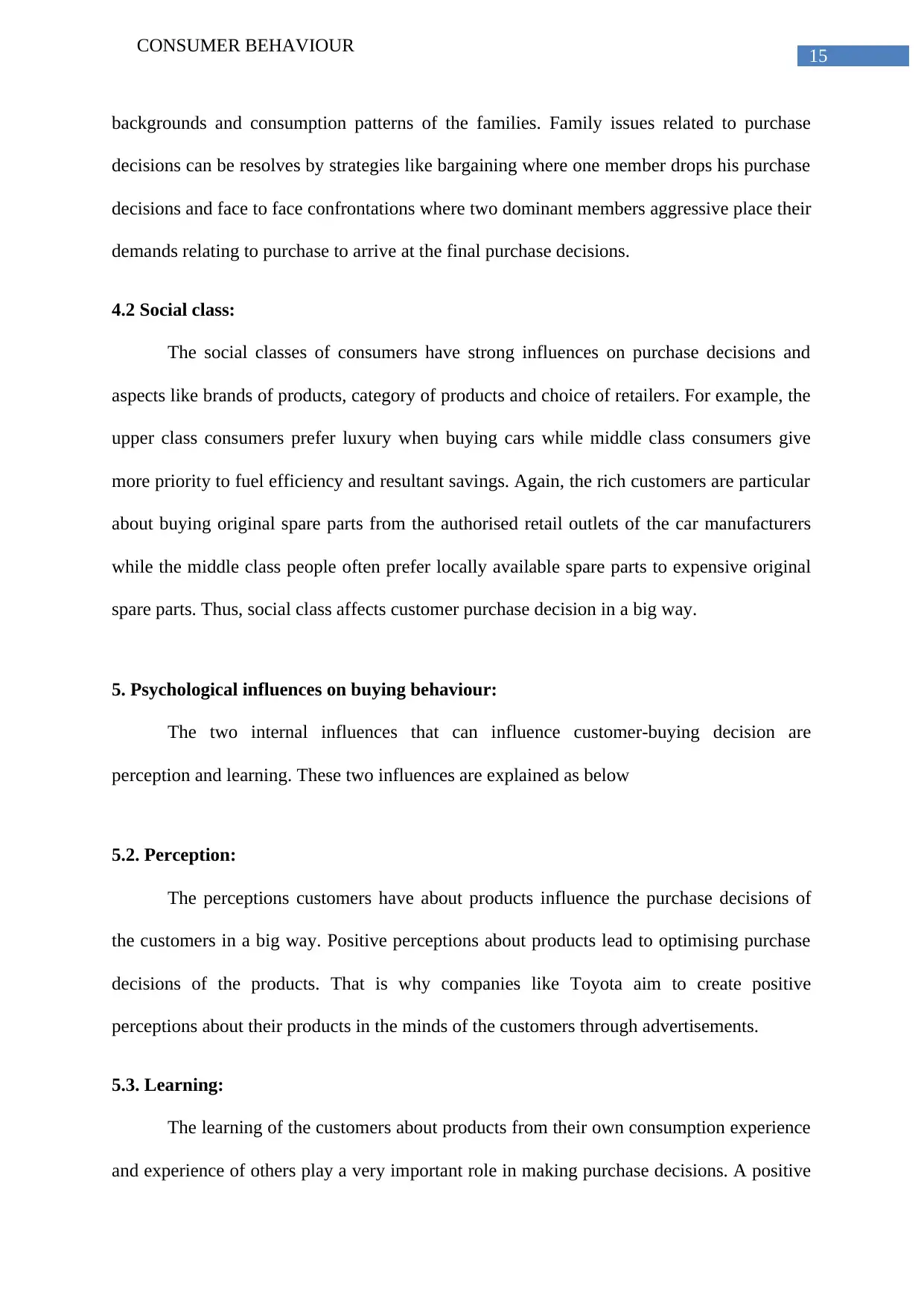
15
CONSUMER BEHAVIOUR
backgrounds and consumption patterns of the families. Family issues related to purchase
decisions can be resolves by strategies like bargaining where one member drops his purchase
decisions and face to face confrontations where two dominant members aggressive place their
demands relating to purchase to arrive at the final purchase decisions.
4.2 Social class:
The social classes of consumers have strong influences on purchase decisions and
aspects like brands of products, category of products and choice of retailers. For example, the
upper class consumers prefer luxury when buying cars while middle class consumers give
more priority to fuel efficiency and resultant savings. Again, the rich customers are particular
about buying original spare parts from the authorised retail outlets of the car manufacturers
while the middle class people often prefer locally available spare parts to expensive original
spare parts. Thus, social class affects customer purchase decision in a big way.
5. Psychological influences on buying behaviour:
The two internal influences that can influence customer-buying decision are
perception and learning. These two influences are explained as below
5.2. Perception:
The perceptions customers have about products influence the purchase decisions of
the customers in a big way. Positive perceptions about products lead to optimising purchase
decisions of the products. That is why companies like Toyota aim to create positive
perceptions about their products in the minds of the customers through advertisements.
5.3. Learning:
The learning of the customers about products from their own consumption experience
and experience of others play a very important role in making purchase decisions. A positive
CONSUMER BEHAVIOUR
backgrounds and consumption patterns of the families. Family issues related to purchase
decisions can be resolves by strategies like bargaining where one member drops his purchase
decisions and face to face confrontations where two dominant members aggressive place their
demands relating to purchase to arrive at the final purchase decisions.
4.2 Social class:
The social classes of consumers have strong influences on purchase decisions and
aspects like brands of products, category of products and choice of retailers. For example, the
upper class consumers prefer luxury when buying cars while middle class consumers give
more priority to fuel efficiency and resultant savings. Again, the rich customers are particular
about buying original spare parts from the authorised retail outlets of the car manufacturers
while the middle class people often prefer locally available spare parts to expensive original
spare parts. Thus, social class affects customer purchase decision in a big way.
5. Psychological influences on buying behaviour:
The two internal influences that can influence customer-buying decision are
perception and learning. These two influences are explained as below
5.2. Perception:
The perceptions customers have about products influence the purchase decisions of
the customers in a big way. Positive perceptions about products lead to optimising purchase
decisions of the products. That is why companies like Toyota aim to create positive
perceptions about their products in the minds of the customers through advertisements.
5.3. Learning:
The learning of the customers about products from their own consumption experience
and experience of others play a very important role in making purchase decisions. A positive
Secure Best Marks with AI Grader
Need help grading? Try our AI Grader for instant feedback on your assignments.
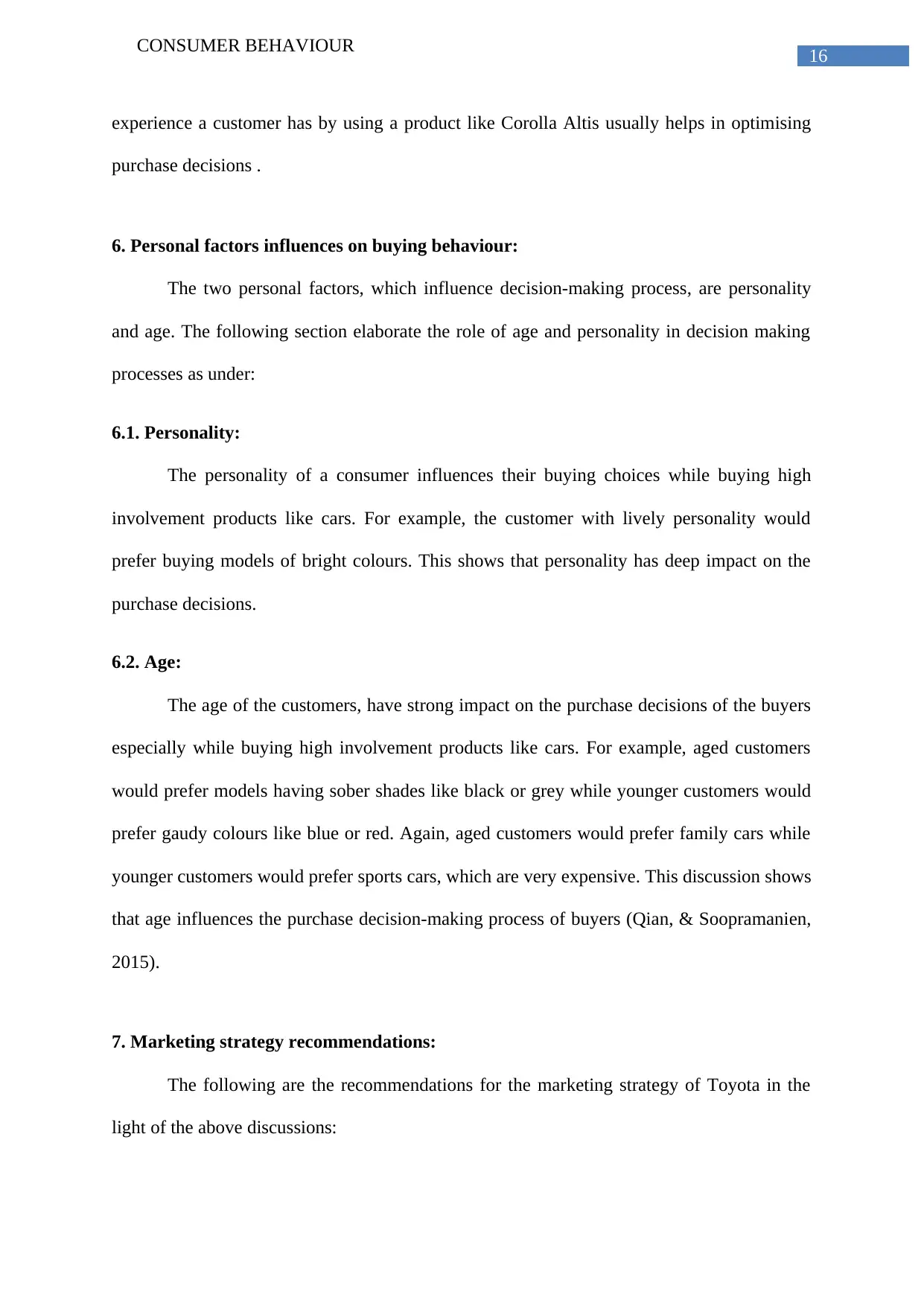
16
CONSUMER BEHAVIOUR
experience a customer has by using a product like Corolla Altis usually helps in optimising
purchase decisions .
6. Personal factors influences on buying behaviour:
The two personal factors, which influence decision-making process, are personality
and age. The following section elaborate the role of age and personality in decision making
processes as under:
6.1. Personality:
The personality of a consumer influences their buying choices while buying high
involvement products like cars. For example, the customer with lively personality would
prefer buying models of bright colours. This shows that personality has deep impact on the
purchase decisions.
6.2. Age:
The age of the customers, have strong impact on the purchase decisions of the buyers
especially while buying high involvement products like cars. For example, aged customers
would prefer models having sober shades like black or grey while younger customers would
prefer gaudy colours like blue or red. Again, aged customers would prefer family cars while
younger customers would prefer sports cars, which are very expensive. This discussion shows
that age influences the purchase decision-making process of buyers (Qian, & Soopramanien,
2015).
7. Marketing strategy recommendations:
The following are the recommendations for the marketing strategy of Toyota in the
light of the above discussions:
CONSUMER BEHAVIOUR
experience a customer has by using a product like Corolla Altis usually helps in optimising
purchase decisions .
6. Personal factors influences on buying behaviour:
The two personal factors, which influence decision-making process, are personality
and age. The following section elaborate the role of age and personality in decision making
processes as under:
6.1. Personality:
The personality of a consumer influences their buying choices while buying high
involvement products like cars. For example, the customer with lively personality would
prefer buying models of bright colours. This shows that personality has deep impact on the
purchase decisions.
6.2. Age:
The age of the customers, have strong impact on the purchase decisions of the buyers
especially while buying high involvement products like cars. For example, aged customers
would prefer models having sober shades like black or grey while younger customers would
prefer gaudy colours like blue or red. Again, aged customers would prefer family cars while
younger customers would prefer sports cars, which are very expensive. This discussion shows
that age influences the purchase decision-making process of buyers (Qian, & Soopramanien,
2015).
7. Marketing strategy recommendations:
The following are the recommendations for the marketing strategy of Toyota in the
light of the above discussions:
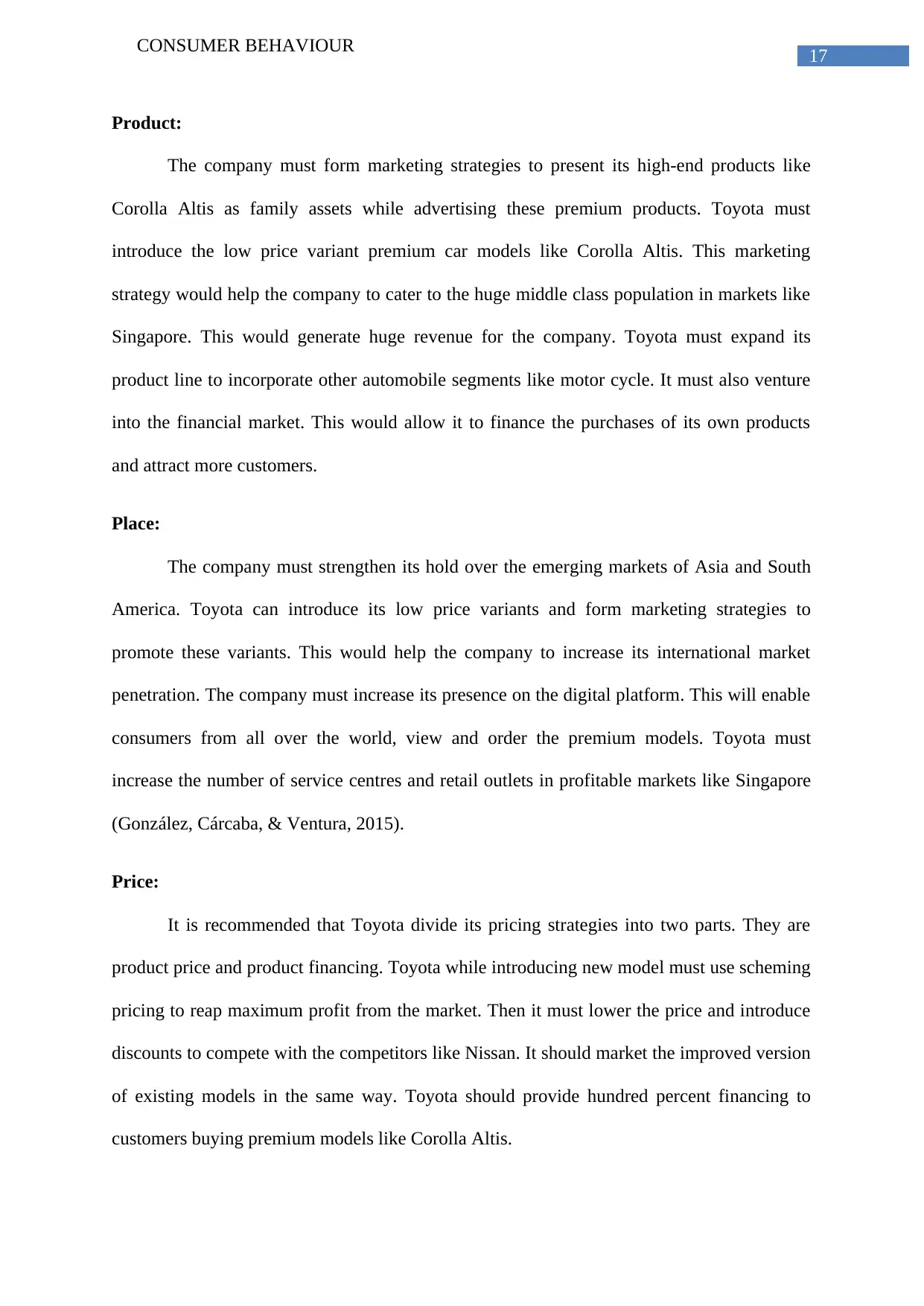
17
CONSUMER BEHAVIOUR
Product:
The company must form marketing strategies to present its high-end products like
Corolla Altis as family assets while advertising these premium products. Toyota must
introduce the low price variant premium car models like Corolla Altis. This marketing
strategy would help the company to cater to the huge middle class population in markets like
Singapore. This would generate huge revenue for the company. Toyota must expand its
product line to incorporate other automobile segments like motor cycle. It must also venture
into the financial market. This would allow it to finance the purchases of its own products
and attract more customers.
Place:
The company must strengthen its hold over the emerging markets of Asia and South
America. Toyota can introduce its low price variants and form marketing strategies to
promote these variants. This would help the company to increase its international market
penetration. The company must increase its presence on the digital platform. This will enable
consumers from all over the world, view and order the premium models. Toyota must
increase the number of service centres and retail outlets in profitable markets like Singapore
(González, Cárcaba, & Ventura, 2015).
Price:
It is recommended that Toyota divide its pricing strategies into two parts. They are
product price and product financing. Toyota while introducing new model must use scheming
pricing to reap maximum profit from the market. Then it must lower the price and introduce
discounts to compete with the competitors like Nissan. It should market the improved version
of existing models in the same way. Toyota should provide hundred percent financing to
customers buying premium models like Corolla Altis.
CONSUMER BEHAVIOUR
Product:
The company must form marketing strategies to present its high-end products like
Corolla Altis as family assets while advertising these premium products. Toyota must
introduce the low price variant premium car models like Corolla Altis. This marketing
strategy would help the company to cater to the huge middle class population in markets like
Singapore. This would generate huge revenue for the company. Toyota must expand its
product line to incorporate other automobile segments like motor cycle. It must also venture
into the financial market. This would allow it to finance the purchases of its own products
and attract more customers.
Place:
The company must strengthen its hold over the emerging markets of Asia and South
America. Toyota can introduce its low price variants and form marketing strategies to
promote these variants. This would help the company to increase its international market
penetration. The company must increase its presence on the digital platform. This will enable
consumers from all over the world, view and order the premium models. Toyota must
increase the number of service centres and retail outlets in profitable markets like Singapore
(González, Cárcaba, & Ventura, 2015).
Price:
It is recommended that Toyota divide its pricing strategies into two parts. They are
product price and product financing. Toyota while introducing new model must use scheming
pricing to reap maximum profit from the market. Then it must lower the price and introduce
discounts to compete with the competitors like Nissan. It should market the improved version
of existing models in the same way. Toyota should provide hundred percent financing to
customers buying premium models like Corolla Altis.
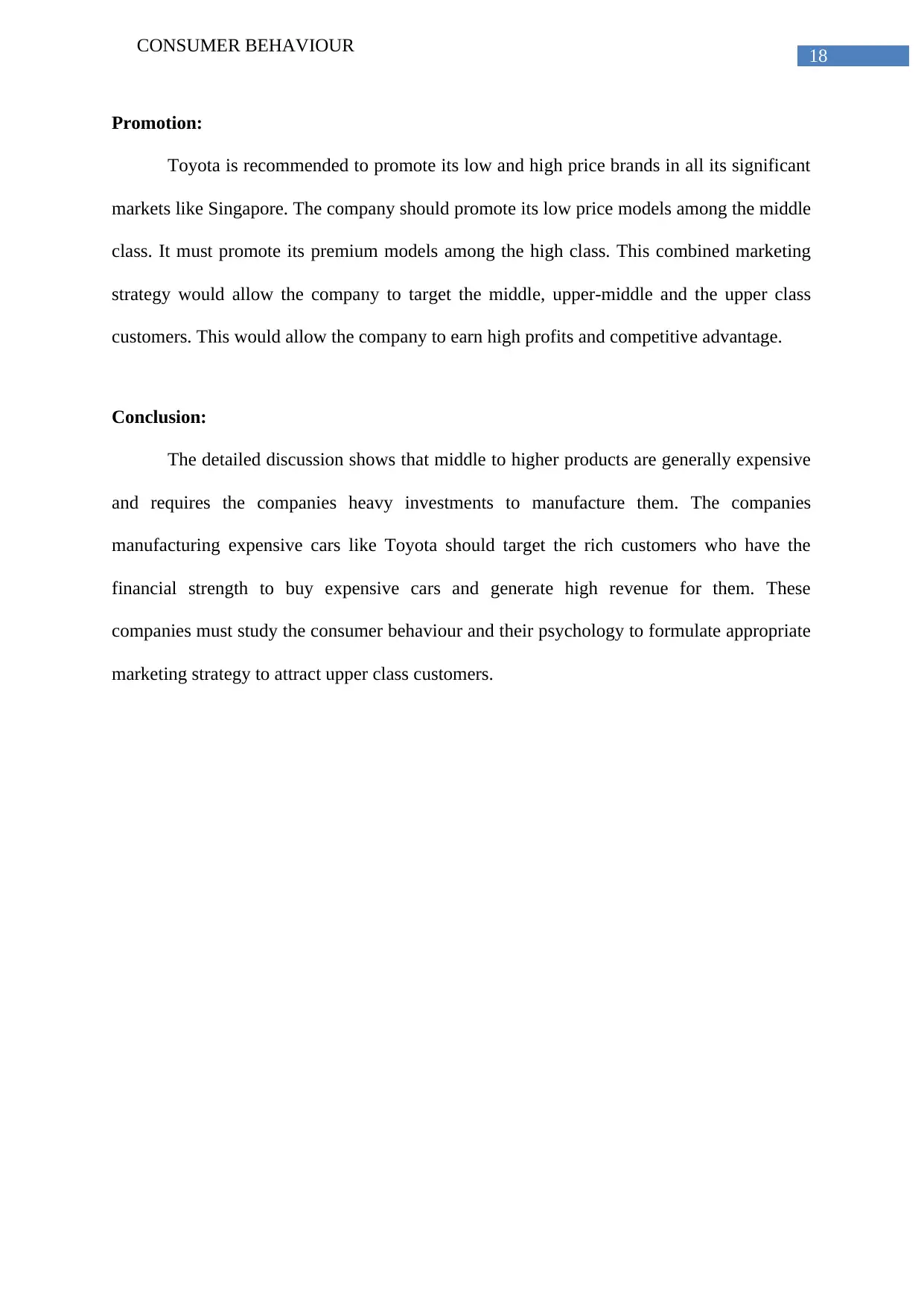
18
CONSUMER BEHAVIOUR
Promotion:
Toyota is recommended to promote its low and high price brands in all its significant
markets like Singapore. The company should promote its low price models among the middle
class. It must promote its premium models among the high class. This combined marketing
strategy would allow the company to target the middle, upper-middle and the upper class
customers. This would allow the company to earn high profits and competitive advantage.
Conclusion:
The detailed discussion shows that middle to higher products are generally expensive
and requires the companies heavy investments to manufacture them. The companies
manufacturing expensive cars like Toyota should target the rich customers who have the
financial strength to buy expensive cars and generate high revenue for them. These
companies must study the consumer behaviour and their psychology to formulate appropriate
marketing strategy to attract upper class customers.
CONSUMER BEHAVIOUR
Promotion:
Toyota is recommended to promote its low and high price brands in all its significant
markets like Singapore. The company should promote its low price models among the middle
class. It must promote its premium models among the high class. This combined marketing
strategy would allow the company to target the middle, upper-middle and the upper class
customers. This would allow the company to earn high profits and competitive advantage.
Conclusion:
The detailed discussion shows that middle to higher products are generally expensive
and requires the companies heavy investments to manufacture them. The companies
manufacturing expensive cars like Toyota should target the rich customers who have the
financial strength to buy expensive cars and generate high revenue for them. These
companies must study the consumer behaviour and their psychology to formulate appropriate
marketing strategy to attract upper class customers.
Paraphrase This Document
Need a fresh take? Get an instant paraphrase of this document with our AI Paraphraser
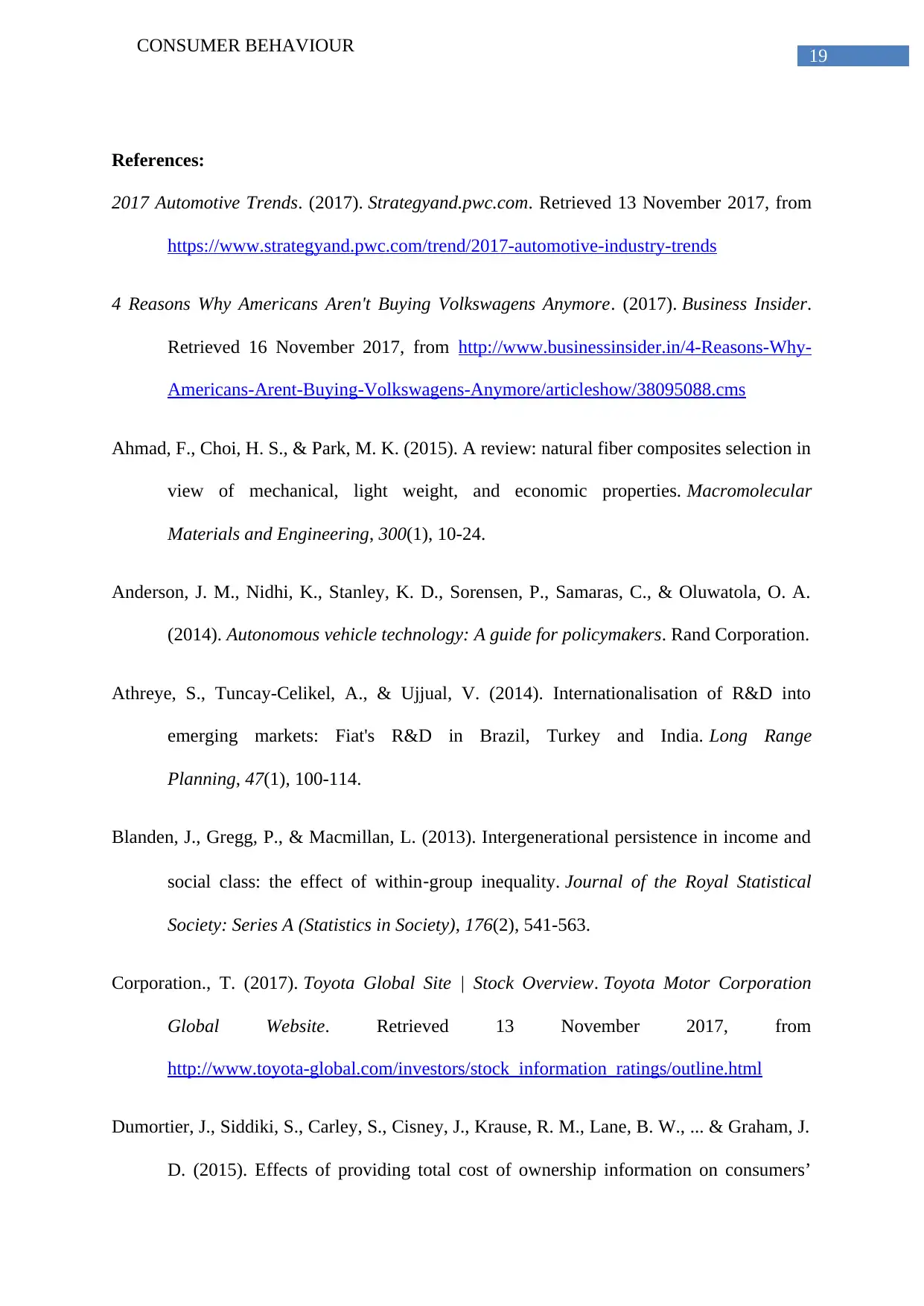
19
CONSUMER BEHAVIOUR
References:
2017 Automotive Trends. (2017). Strategyand.pwc.com. Retrieved 13 November 2017, from
https://www.strategyand.pwc.com/trend/2017-automotive-industry-trends
4 Reasons Why Americans Aren't Buying Volkswagens Anymore. (2017). Business Insider.
Retrieved 16 November 2017, from http://www.businessinsider.in/4-Reasons-Why-
Americans-Arent-Buying-Volkswagens-Anymore/articleshow/38095088.cms
Ahmad, F., Choi, H. S., & Park, M. K. (2015). A review: natural fiber composites selection in
view of mechanical, light weight, and economic properties. Macromolecular
Materials and Engineering, 300(1), 10-24.
Anderson, J. M., Nidhi, K., Stanley, K. D., Sorensen, P., Samaras, C., & Oluwatola, O. A.
(2014). Autonomous vehicle technology: A guide for policymakers. Rand Corporation.
Athreye, S., Tuncay-Celikel, A., & Ujjual, V. (2014). Internationalisation of R&D into
emerging markets: Fiat's R&D in Brazil, Turkey and India. Long Range
Planning, 47(1), 100-114.
Blanden, J., Gregg, P., & Macmillan, L. (2013). Intergenerational persistence in income and
social class: the effect of within‐group inequality. Journal of the Royal Statistical
Society: Series A (Statistics in Society), 176(2), 541-563.
Corporation., T. (2017). Toyota Global Site | Stock Overview. Toyota Motor Corporation
Global Website. Retrieved 13 November 2017, from
http://www.toyota-global.com/investors/stock_information_ratings/outline.html
Dumortier, J., Siddiki, S., Carley, S., Cisney, J., Krause, R. M., Lane, B. W., ... & Graham, J.
D. (2015). Effects of providing total cost of ownership information on consumers’
CONSUMER BEHAVIOUR
References:
2017 Automotive Trends. (2017). Strategyand.pwc.com. Retrieved 13 November 2017, from
https://www.strategyand.pwc.com/trend/2017-automotive-industry-trends
4 Reasons Why Americans Aren't Buying Volkswagens Anymore. (2017). Business Insider.
Retrieved 16 November 2017, from http://www.businessinsider.in/4-Reasons-Why-
Americans-Arent-Buying-Volkswagens-Anymore/articleshow/38095088.cms
Ahmad, F., Choi, H. S., & Park, M. K. (2015). A review: natural fiber composites selection in
view of mechanical, light weight, and economic properties. Macromolecular
Materials and Engineering, 300(1), 10-24.
Anderson, J. M., Nidhi, K., Stanley, K. D., Sorensen, P., Samaras, C., & Oluwatola, O. A.
(2014). Autonomous vehicle technology: A guide for policymakers. Rand Corporation.
Athreye, S., Tuncay-Celikel, A., & Ujjual, V. (2014). Internationalisation of R&D into
emerging markets: Fiat's R&D in Brazil, Turkey and India. Long Range
Planning, 47(1), 100-114.
Blanden, J., Gregg, P., & Macmillan, L. (2013). Intergenerational persistence in income and
social class: the effect of within‐group inequality. Journal of the Royal Statistical
Society: Series A (Statistics in Society), 176(2), 541-563.
Corporation., T. (2017). Toyota Global Site | Stock Overview. Toyota Motor Corporation
Global Website. Retrieved 13 November 2017, from
http://www.toyota-global.com/investors/stock_information_ratings/outline.html
Dumortier, J., Siddiki, S., Carley, S., Cisney, J., Krause, R. M., Lane, B. W., ... & Graham, J.
D. (2015). Effects of providing total cost of ownership information on consumers’
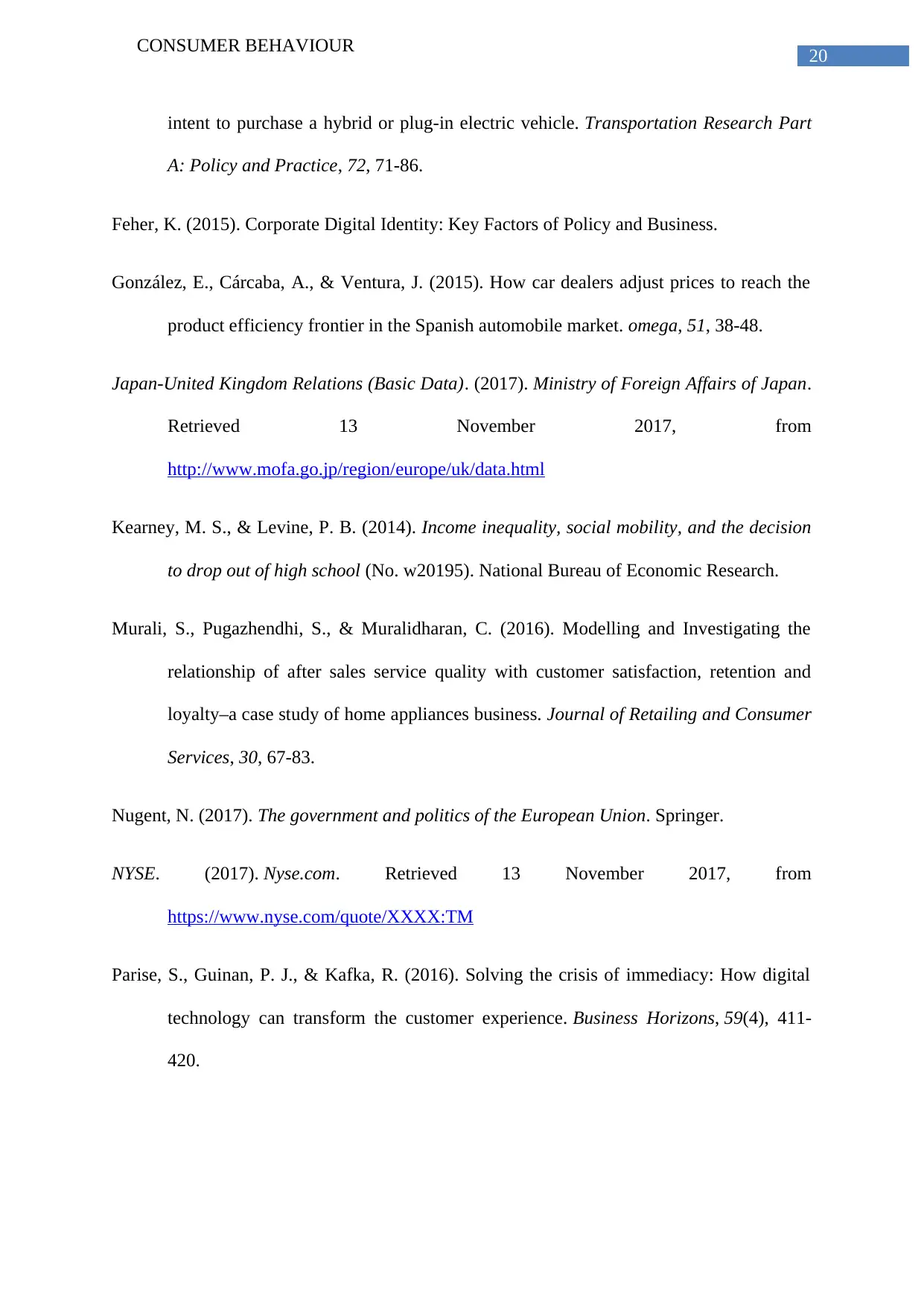
20
CONSUMER BEHAVIOUR
intent to purchase a hybrid or plug-in electric vehicle. Transportation Research Part
A: Policy and Practice, 72, 71-86.
Feher, K. (2015). Corporate Digital Identity: Key Factors of Policy and Business.
González, E., Cárcaba, A., & Ventura, J. (2015). How car dealers adjust prices to reach the
product efficiency frontier in the Spanish automobile market. omega, 51, 38-48.
Japan-United Kingdom Relations (Basic Data). (2017). Ministry of Foreign Affairs of Japan.
Retrieved 13 November 2017, from
http://www.mofa.go.jp/region/europe/uk/data.html
Kearney, M. S., & Levine, P. B. (2014). Income inequality, social mobility, and the decision
to drop out of high school (No. w20195). National Bureau of Economic Research.
Murali, S., Pugazhendhi, S., & Muralidharan, C. (2016). Modelling and Investigating the
relationship of after sales service quality with customer satisfaction, retention and
loyalty–a case study of home appliances business. Journal of Retailing and Consumer
Services, 30, 67-83.
Nugent, N. (2017). The government and politics of the European Union. Springer.
NYSE. (2017). Nyse.com. Retrieved 13 November 2017, from
https://www.nyse.com/quote/XXXX:TM
Parise, S., Guinan, P. J., & Kafka, R. (2016). Solving the crisis of immediacy: How digital
technology can transform the customer experience. Business Horizons, 59(4), 411-
420.
CONSUMER BEHAVIOUR
intent to purchase a hybrid or plug-in electric vehicle. Transportation Research Part
A: Policy and Practice, 72, 71-86.
Feher, K. (2015). Corporate Digital Identity: Key Factors of Policy and Business.
González, E., Cárcaba, A., & Ventura, J. (2015). How car dealers adjust prices to reach the
product efficiency frontier in the Spanish automobile market. omega, 51, 38-48.
Japan-United Kingdom Relations (Basic Data). (2017). Ministry of Foreign Affairs of Japan.
Retrieved 13 November 2017, from
http://www.mofa.go.jp/region/europe/uk/data.html
Kearney, M. S., & Levine, P. B. (2014). Income inequality, social mobility, and the decision
to drop out of high school (No. w20195). National Bureau of Economic Research.
Murali, S., Pugazhendhi, S., & Muralidharan, C. (2016). Modelling and Investigating the
relationship of after sales service quality with customer satisfaction, retention and
loyalty–a case study of home appliances business. Journal of Retailing and Consumer
Services, 30, 67-83.
Nugent, N. (2017). The government and politics of the European Union. Springer.
NYSE. (2017). Nyse.com. Retrieved 13 November 2017, from
https://www.nyse.com/quote/XXXX:TM
Parise, S., Guinan, P. J., & Kafka, R. (2016). Solving the crisis of immediacy: How digital
technology can transform the customer experience. Business Horizons, 59(4), 411-
420.
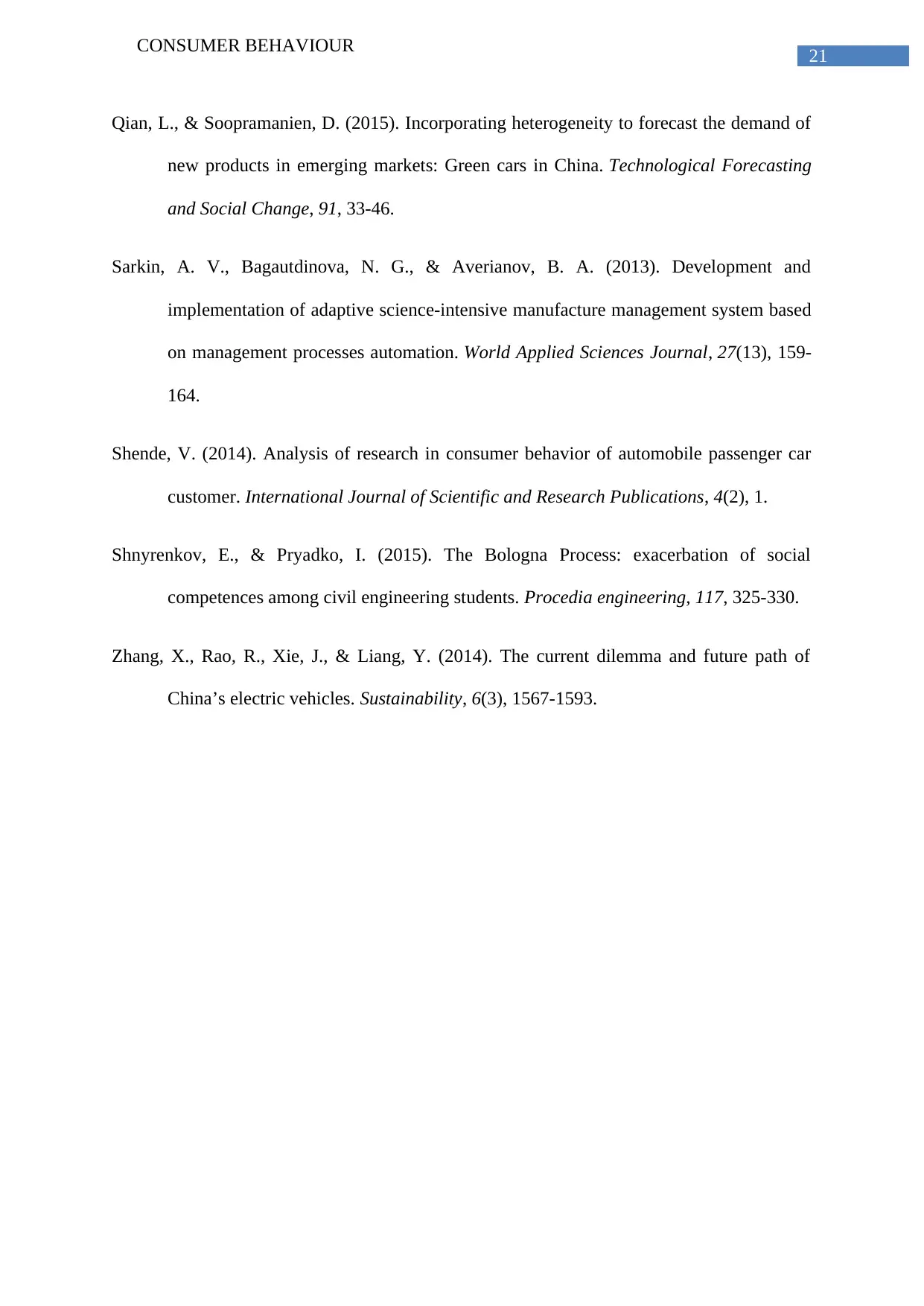
21
CONSUMER BEHAVIOUR
Qian, L., & Soopramanien, D. (2015). Incorporating heterogeneity to forecast the demand of
new products in emerging markets: Green cars in China. Technological Forecasting
and Social Change, 91, 33-46.
Sarkin, A. V., Bagautdinova, N. G., & Averianov, B. A. (2013). Development and
implementation of adaptive science-intensive manufacture management system based
on management processes automation. World Applied Sciences Journal, 27(13), 159-
164.
Shende, V. (2014). Analysis of research in consumer behavior of automobile passenger car
customer. International Journal of Scientific and Research Publications, 4(2), 1.
Shnyrenkov, E., & Pryadko, I. (2015). The Bologna Process: exacerbation of social
competences among civil engineering students. Procedia engineering, 117, 325-330.
Zhang, X., Rao, R., Xie, J., & Liang, Y. (2014). The current dilemma and future path of
China’s electric vehicles. Sustainability, 6(3), 1567-1593.
CONSUMER BEHAVIOUR
Qian, L., & Soopramanien, D. (2015). Incorporating heterogeneity to forecast the demand of
new products in emerging markets: Green cars in China. Technological Forecasting
and Social Change, 91, 33-46.
Sarkin, A. V., Bagautdinova, N. G., & Averianov, B. A. (2013). Development and
implementation of adaptive science-intensive manufacture management system based
on management processes automation. World Applied Sciences Journal, 27(13), 159-
164.
Shende, V. (2014). Analysis of research in consumer behavior of automobile passenger car
customer. International Journal of Scientific and Research Publications, 4(2), 1.
Shnyrenkov, E., & Pryadko, I. (2015). The Bologna Process: exacerbation of social
competences among civil engineering students. Procedia engineering, 117, 325-330.
Zhang, X., Rao, R., Xie, J., & Liang, Y. (2014). The current dilemma and future path of
China’s electric vehicles. Sustainability, 6(3), 1567-1593.
1 out of 22
Related Documents
Your All-in-One AI-Powered Toolkit for Academic Success.
+13062052269
info@desklib.com
Available 24*7 on WhatsApp / Email
![[object Object]](/_next/static/media/star-bottom.7253800d.svg)
Unlock your academic potential
© 2024 | Zucol Services PVT LTD | All rights reserved.





